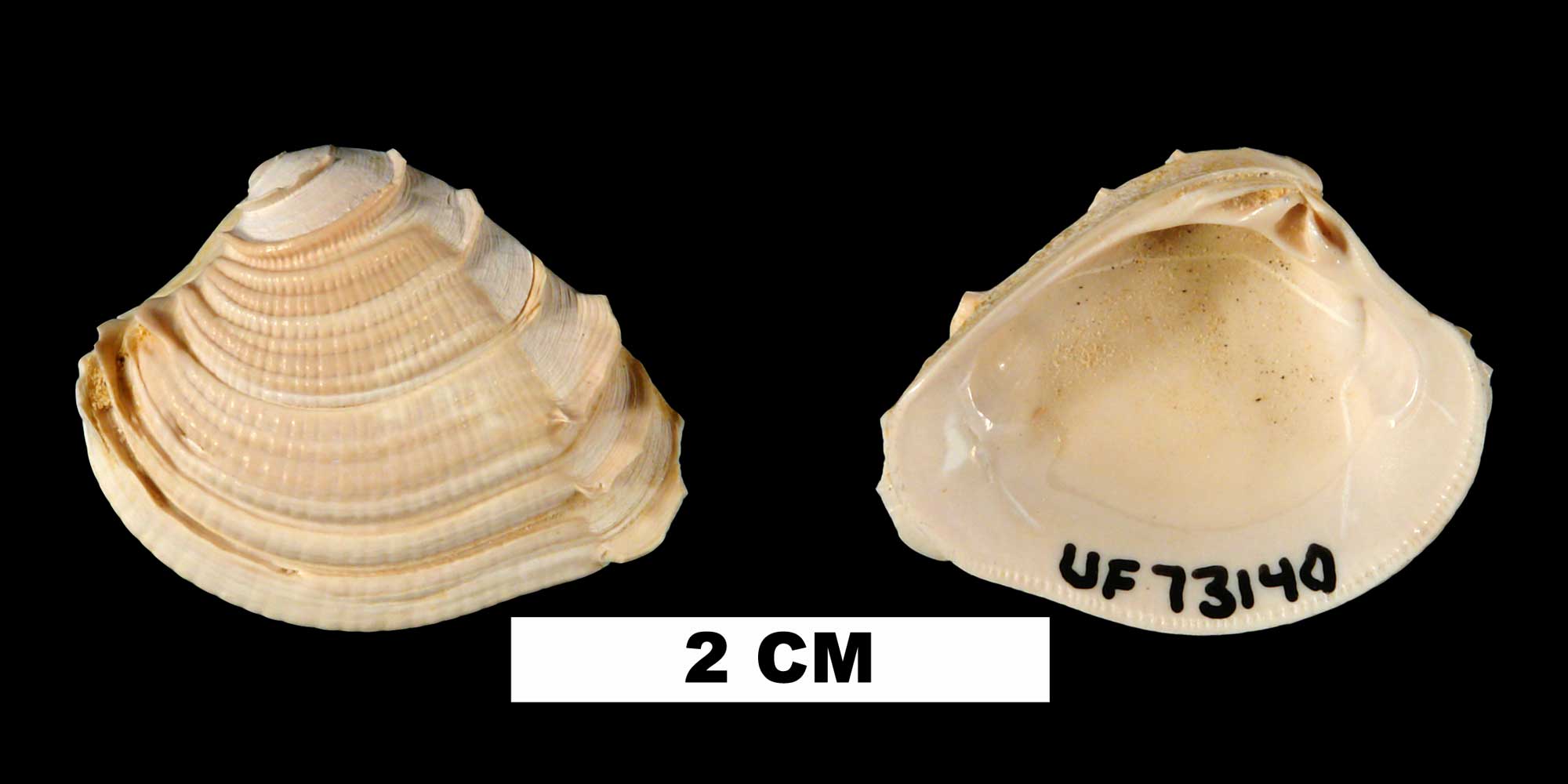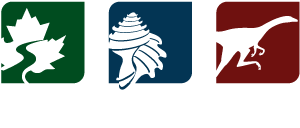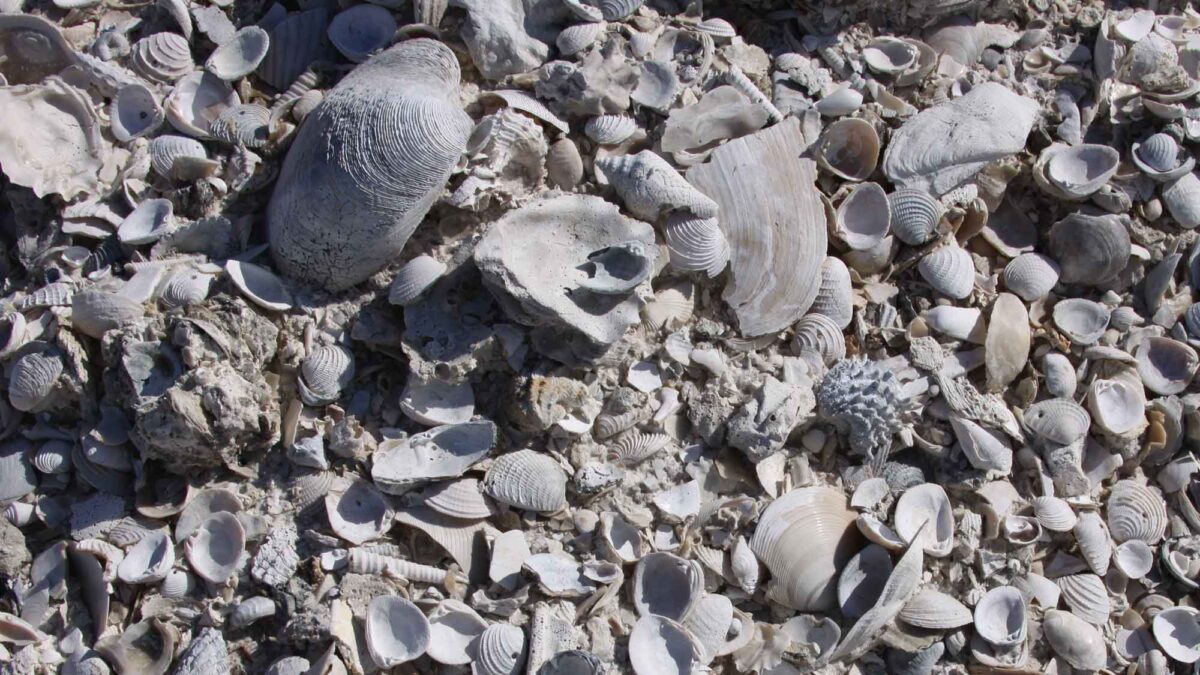Overview
Efforts at bivalve classification and phylogenetic analysis have traditionally been based on prominent morphological features such as gill structure, stomach morphology, hinge teeth, siphons, etc. More recently, molecular data have begun to play a much more important role. This is a very active field of research today and hypotheses are still somewhat in flux, although the major features of the Tree of Life for bivalves have stabilized in recent years. A particular challenge is combining fossil and living taxa in a single phylogeny, because of the distinctive morphologies of many fossil groups and the large number of missing characters in fossil taxa (no soft bodies or molecules). The scheme used here is based on analyses of morphology and molecular data by Bieler et al. (2014), Combosch et al. (2017), and Ponder et al. (2020).
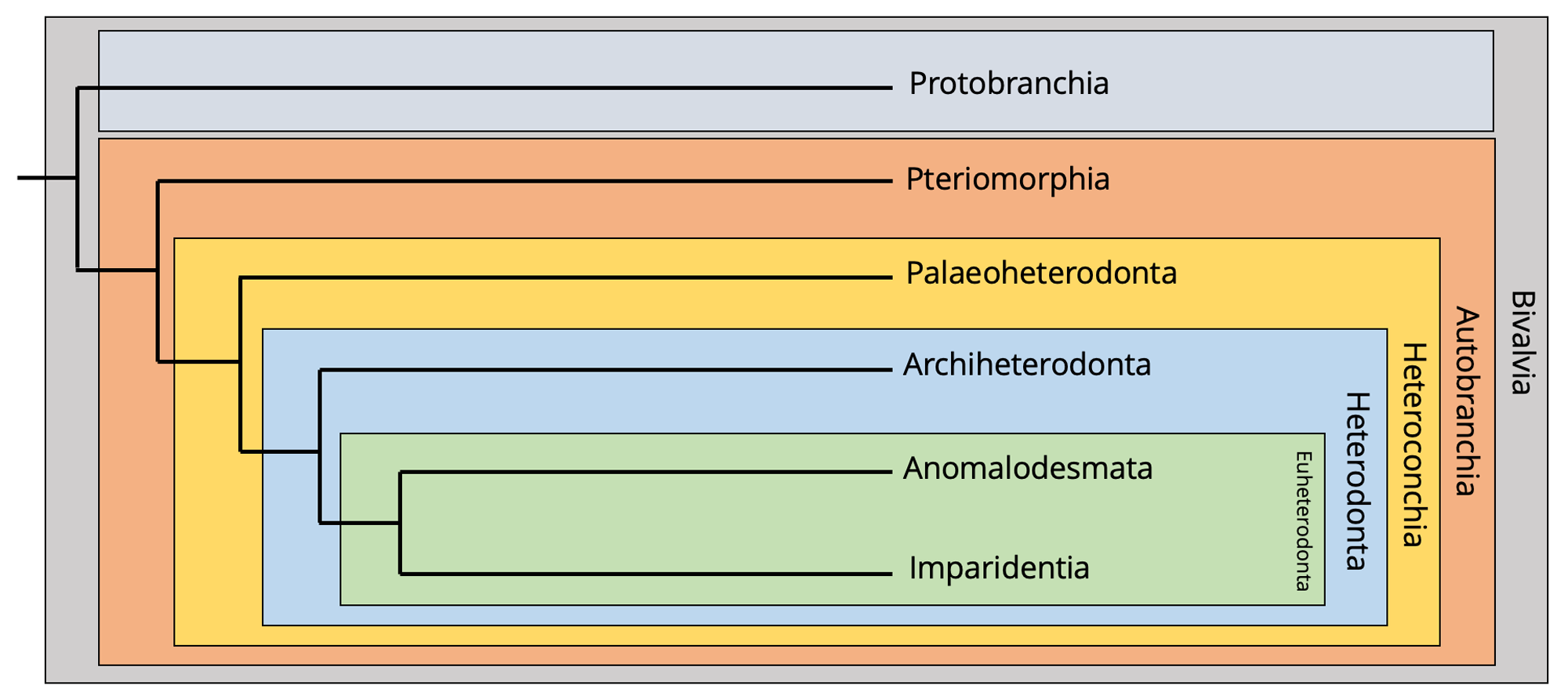
Simplified phylogeny of Recent bivalves (based on Bieler et al., 2014).
Subclass Protobranchia
Nut Clams and other deposit-feeding bivalves with a wide, frilly “plantar” foot for shallow “plowing” through soft sediment; highest diversity in the deep sea; includes Nucula with unfused mantle margins, internally nacreous, taxodont teeth, smooth shells, enlarged labial palps with palp proboscides for deposit feeding, gills for respiration only.
Orders (with additional resources):
- Nuculanida (WoRMS; Neogene Atlas; Cretaceous Atlas; FossilWorks)
- Nuculida (WoRMS; Neogene Atlas; Cretaceous Atlas; FossilWorks)
- Solemyida (WoRMS; Cretaceous Atlas; FossilWorks)
Examples of Protobranchia:
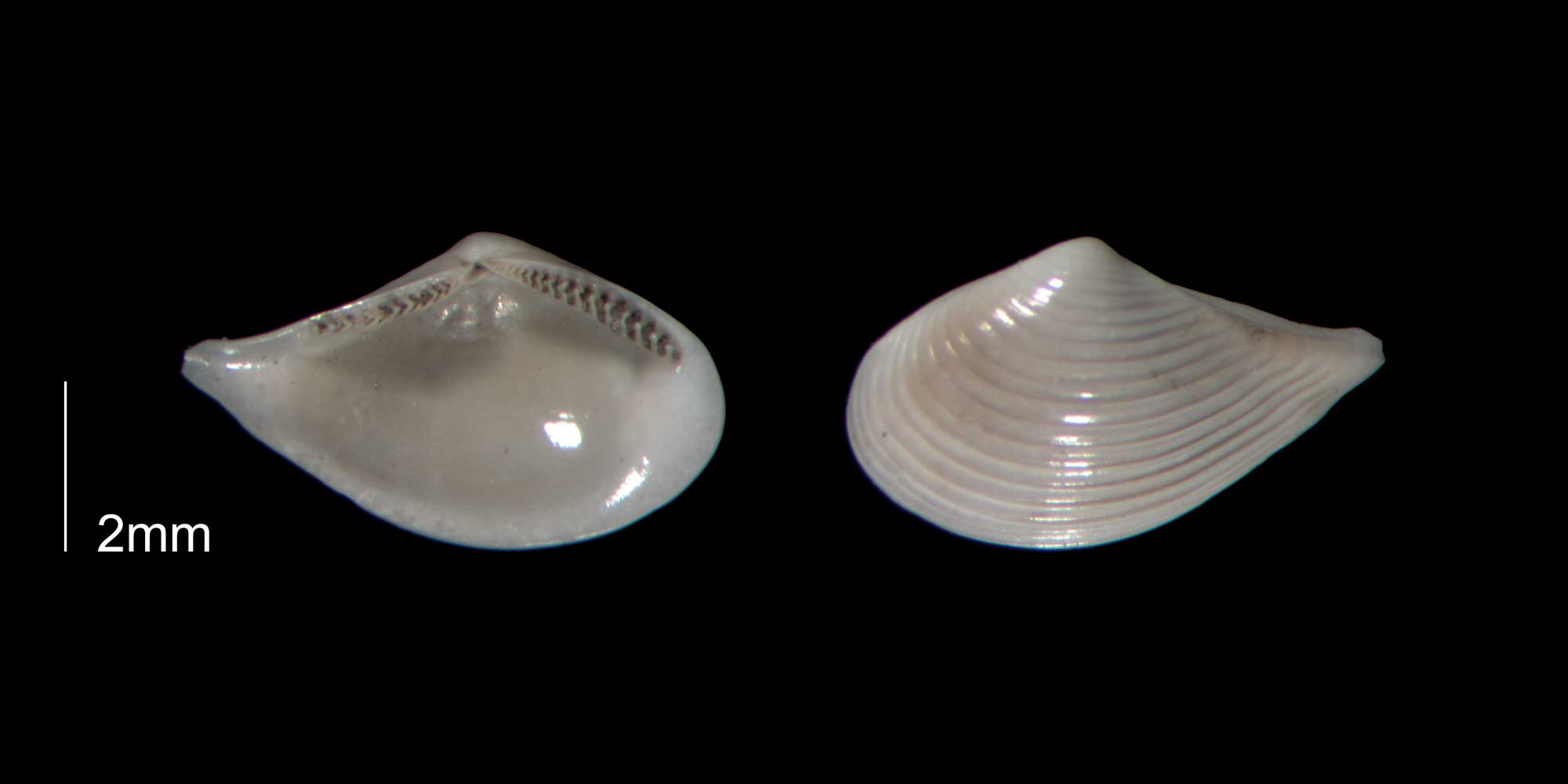
Order Nuculanida. Nuculana acuta from the Early Pleistocene Waccamaw Fm. of Brunswick County, North Carolina (PRI 70436). Image from the Neogene Atlas.
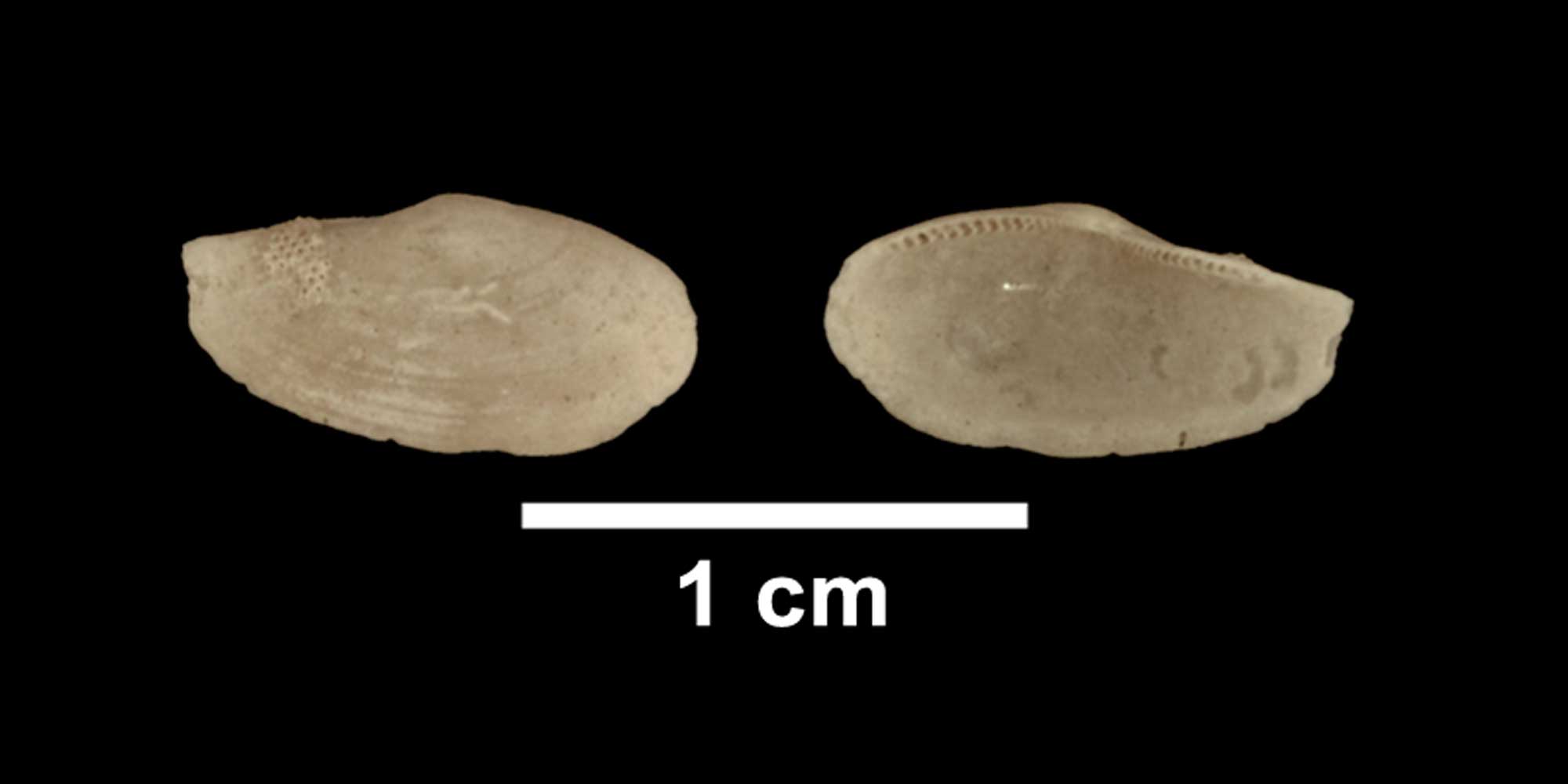
Order Nuculanida. Yoldia laevis from the Late Pliocene Yorktown Fm. of Suffolk County, Virginia (SDSM 136153). Image from the Neogene Atlas.
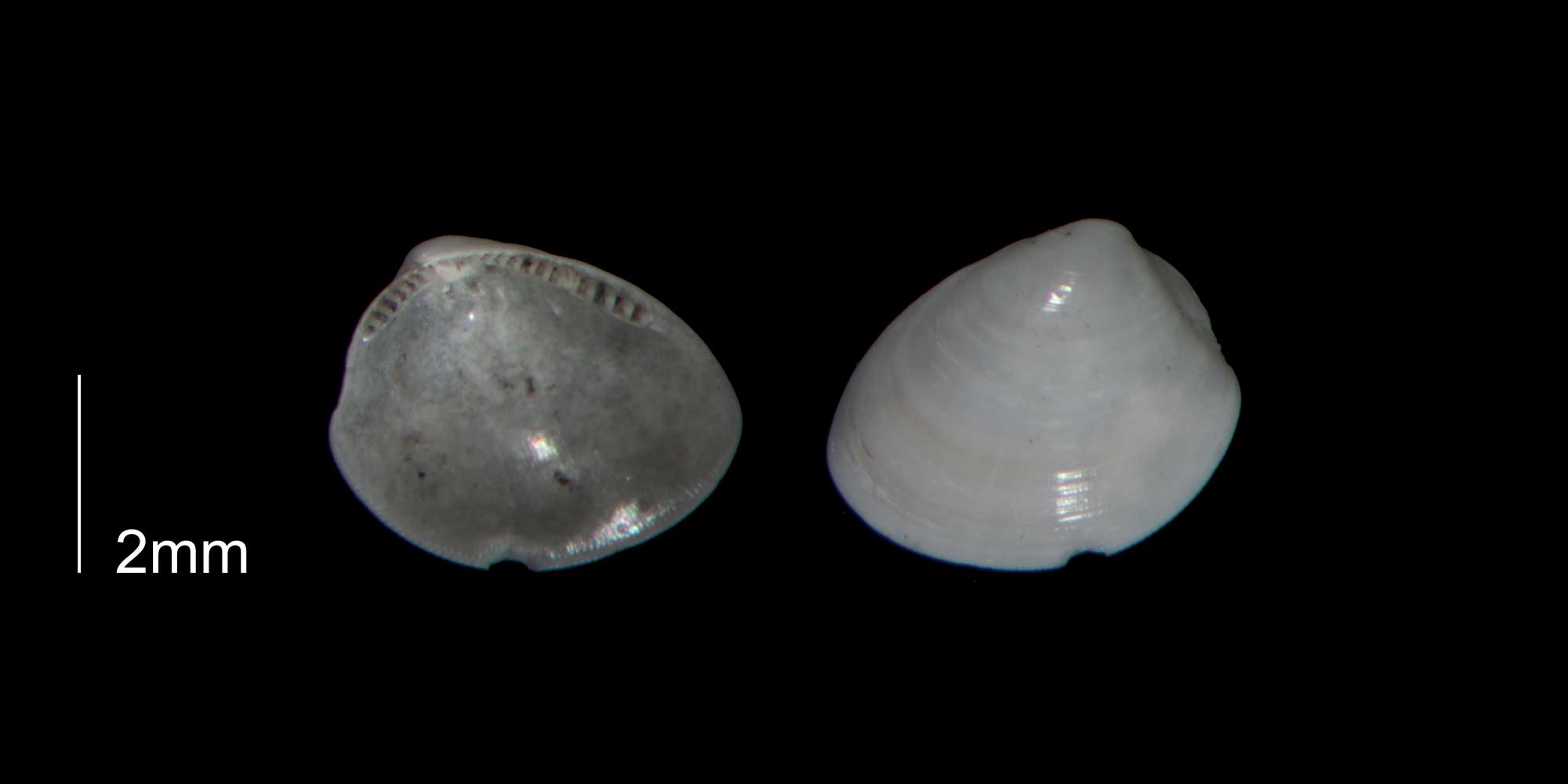
Order Nuculida. Nucula proxima from the Early Pleistocene Waccamaw Fm. of Brunswick County, North Carolina (PRI 70425). Image from the Neogene Atlas.
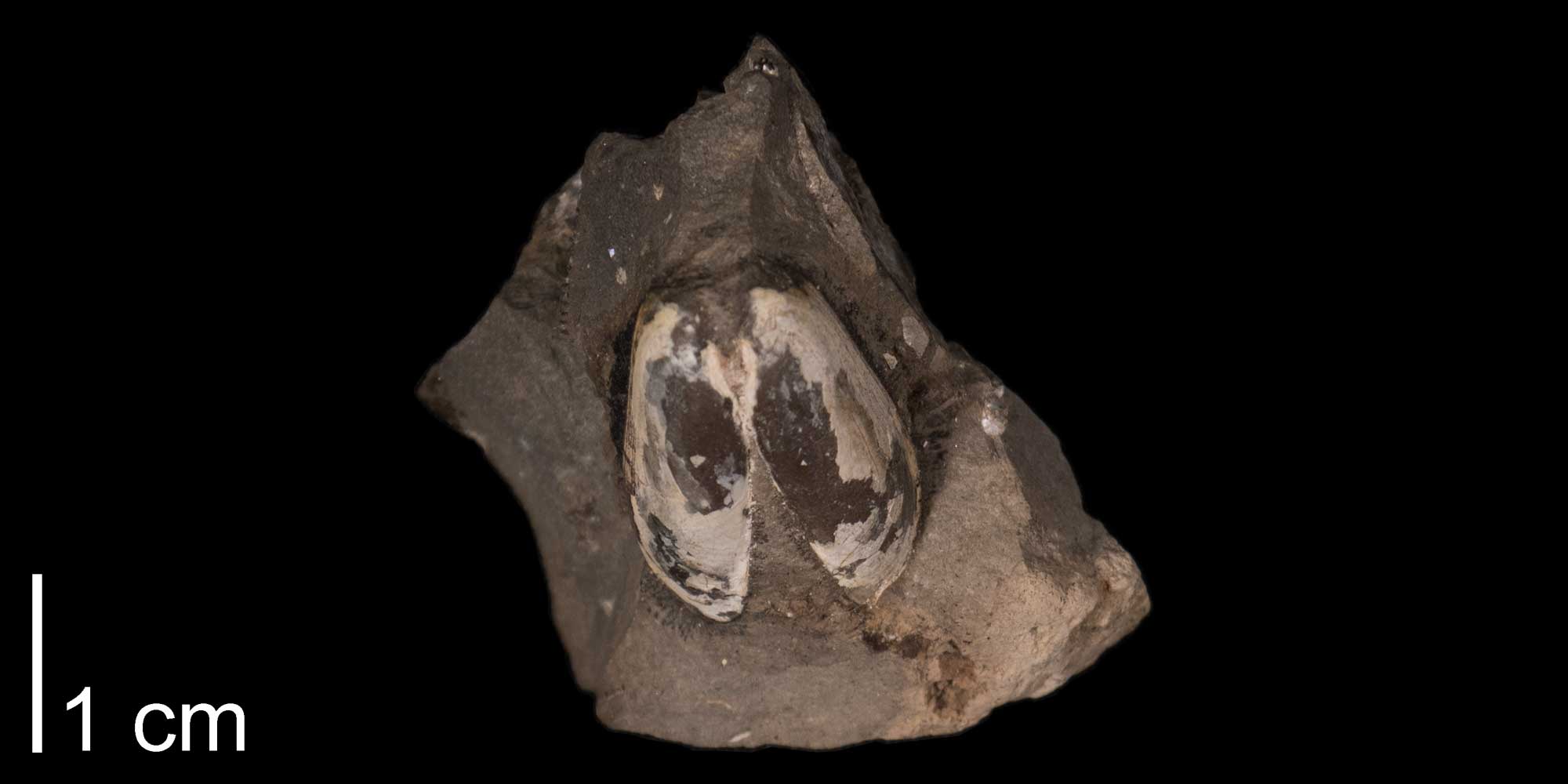
Order Solemyida. Solemya bilix from the Pierre Formation of Meade County, South Dakota (FHSMIP 1336). Image from the Cretaceous Atlas.
Subclass Autobranchia
Bivalves with gills in a W-shaped configuration on each side of the visceral mass, for respiration and feeding.
Infraclass Pteriomorphia
Mussels, Scallops, Pearl Oysters, and other non-burrowing bivalves with unfused mantle margins, large filter-feeding gills, and reduced foot. Most are monomyarian and byssate.
Pteriomorphia Example 1: Oysters (Ostrea)
Chalky, irregular shell; cementing.
Fossil specimen of the oyster Ostrea sp., purportedly from the Miocene of Spain (PRI 70602). Specimen is from the collections of the Paleontological Research Institution, Ithaca, New York. Maximum length of specimen is approximately 11.5 cm (Sketchfab; CC0 public domain).
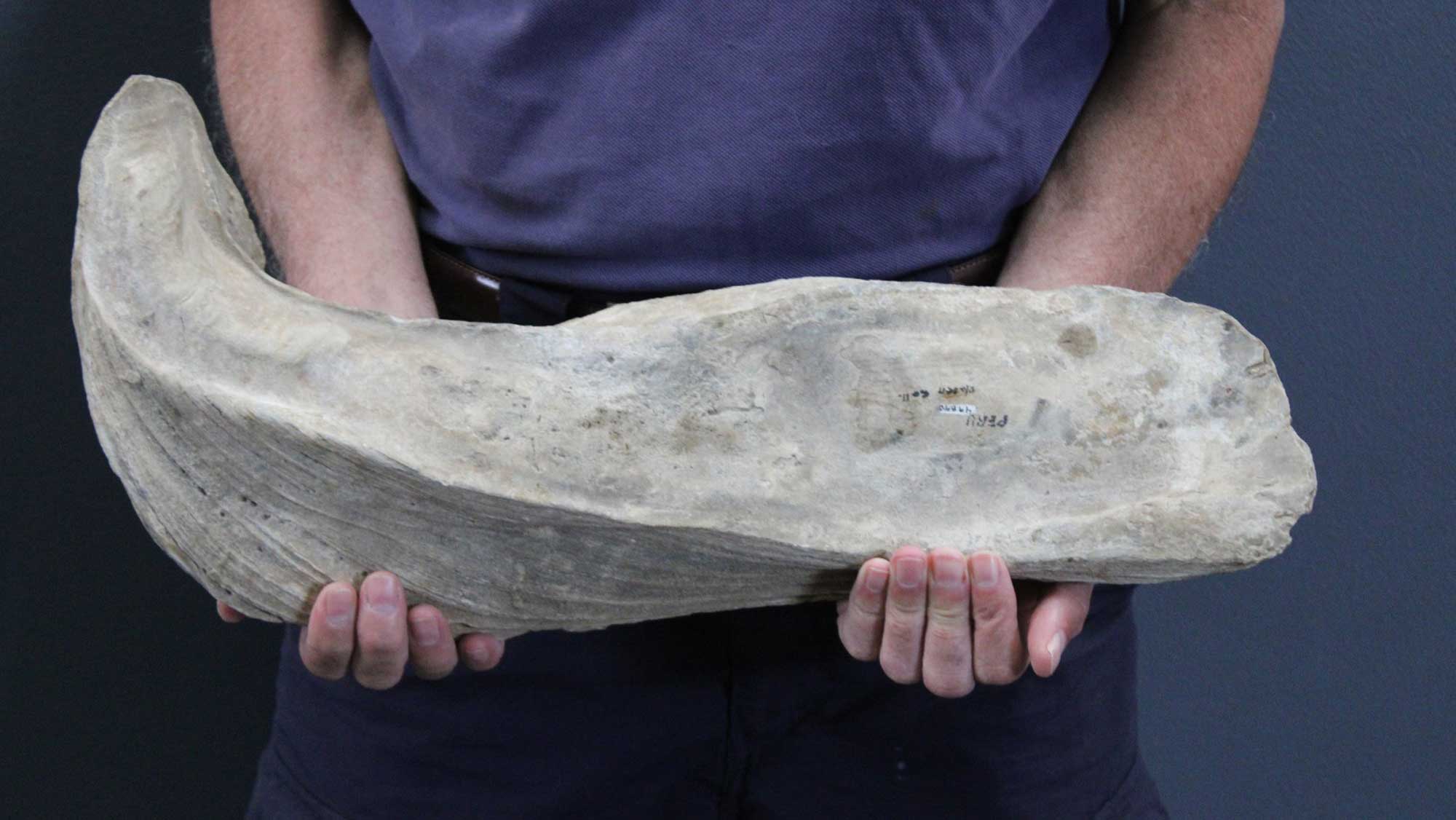
Giant oyster (Ostrea sp.) from the Cretaceous of Peru (PRI 49890).
Pteriomorphia Example 2: Scallop (Argopecten)
Almost round, flat valves with dorsal auricles (“ears”); pallial veil with multiple pallial eyes and sensory pallial tentacles; ability to swim by clapping valves together.
Fossil specimen of the bivalve scallop Argopecten gibbus from the Neogene (Pliocene) of Sarasota County, Florida (PRI 50125). Specimen is from the collections of the Paleontological Research Institution, Ithaca, New York. Width of specimen is approximately 6 cm (Sketchfab; CC0 public domain). Click here for a view showing both valves together.
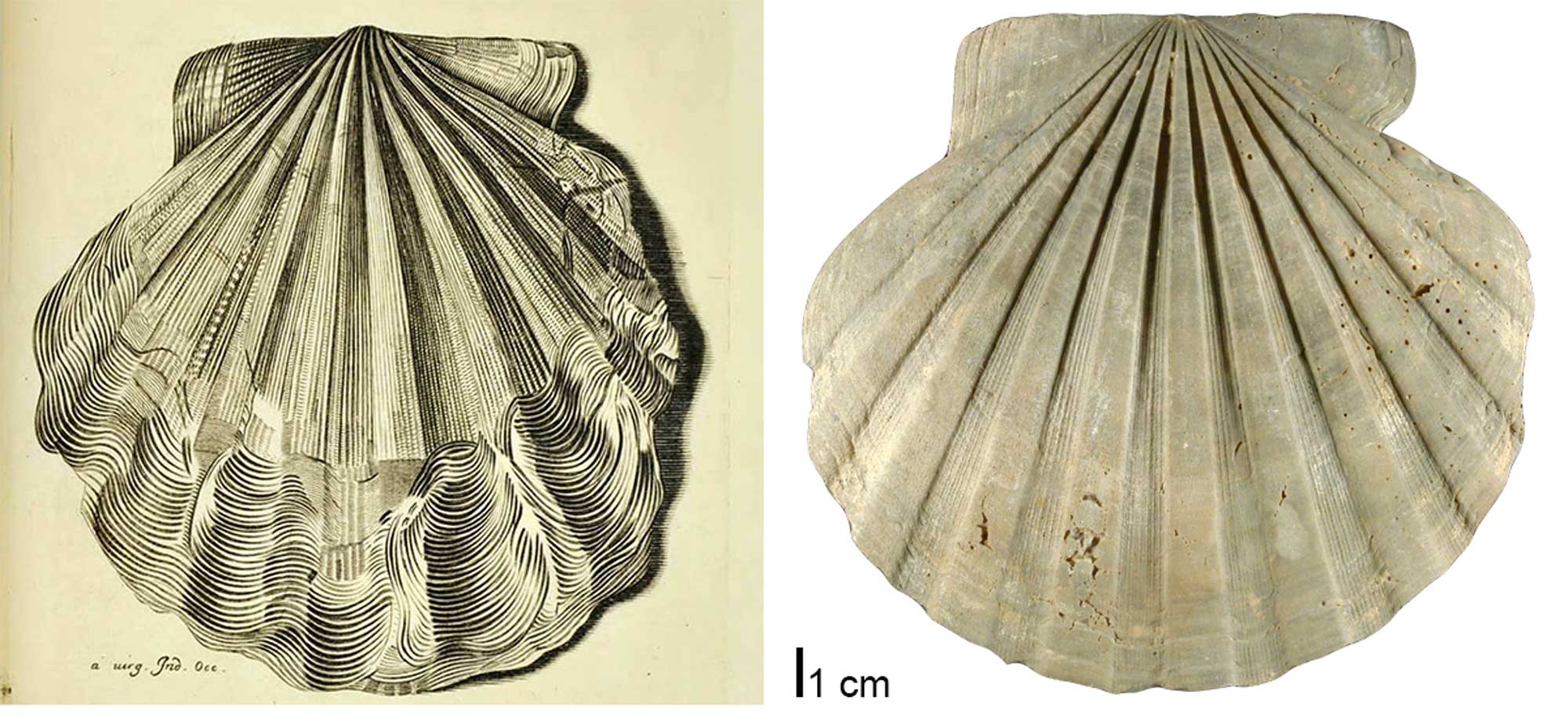
"Swimming Bay Scallops Homosassa Florida" by Brian Dombrowski (YouTube).
Orders of Pteriomorphia (with additional resources):
- Arcida (WoRMS; Neogene Atlas; Cretaceous Atlas; FossilWorks)
- Colpomyida† (FossilWorks)
- Cyrtodontida† (FossilWorks)
- Limida (WoRMS; Neogene Atlas; FossilWorks)
- Myalinida† (Cretaceous Atlas; FossilWorks)
- Mytilida (WoRMS; Neogene Atlas; Cretaceous Atlas; FossilWorks)
- Ostreida (WoRMS; Neogene Atlas; FossilWorks)
- Pectinida (WoRMS; Neogene Atlas; FossilWorks)
- Pteriida (WoRMS [treated as Ostreida]; FossilWorks)
Relationships of Pteriomorphia
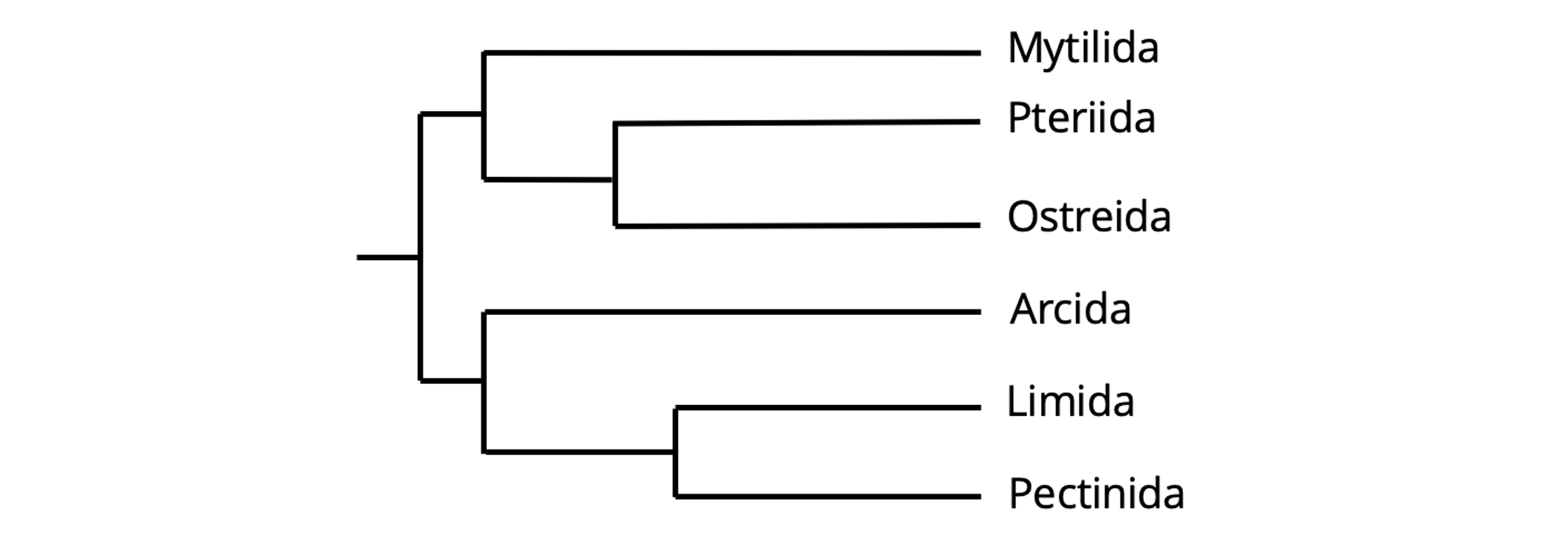
Simplified phylogeny of Recent pteriomorph bivalves (based on Combosch et al., 2017).
Additional Examples of Pteriomorphia
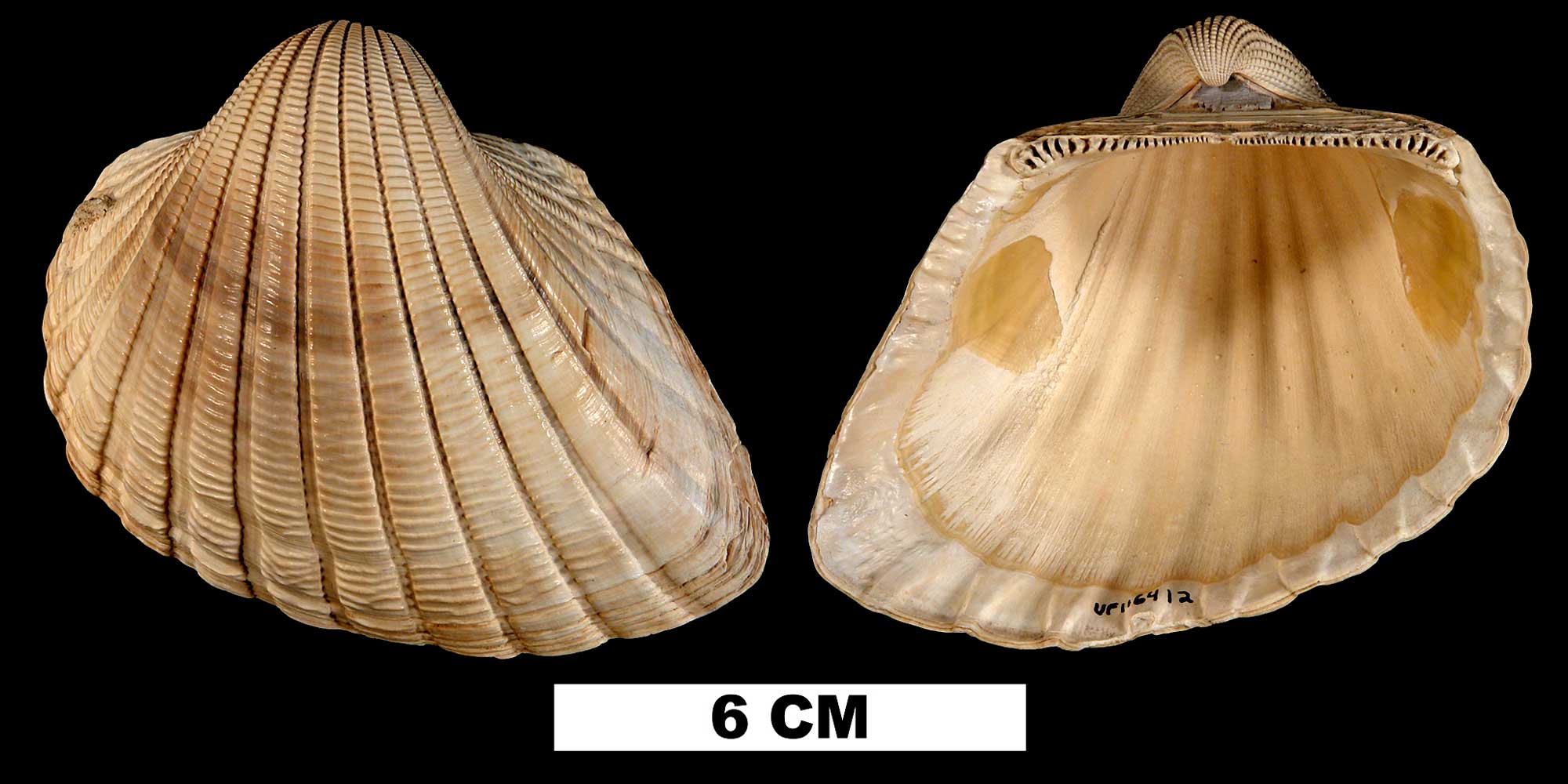
Order Arcida. Anadara scalarina from the Early Pleistocene Caloosahatchee Fm. of Okeechobee County, Florida (UF 116412). Image from the Neogene Atlas.
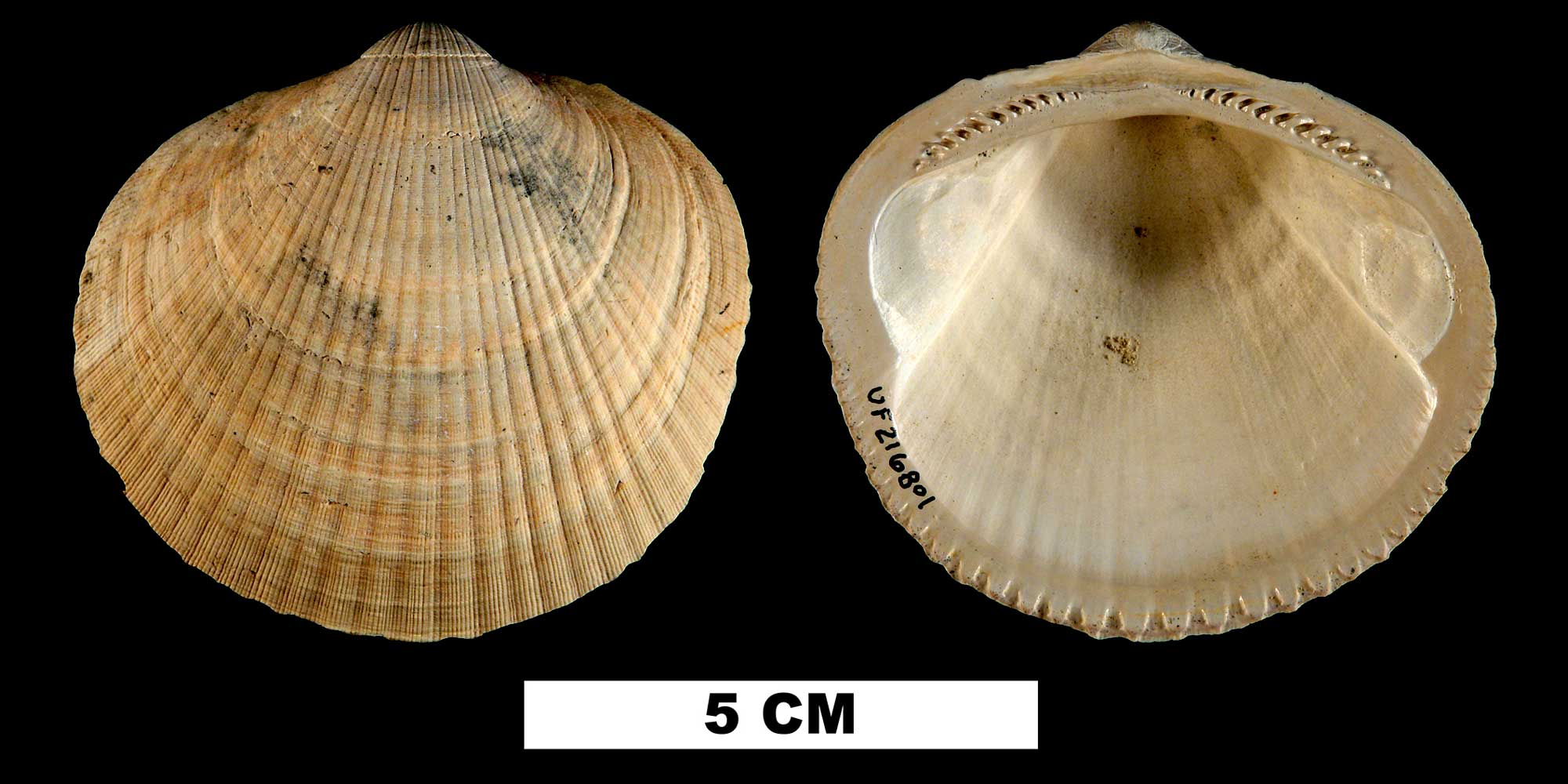
Order Arcida. Glycymeris americana from the Early Pleistocene Nashua Fm. of St. Johns County, Florida (UF 216801). Image from the Neogene Atlas.
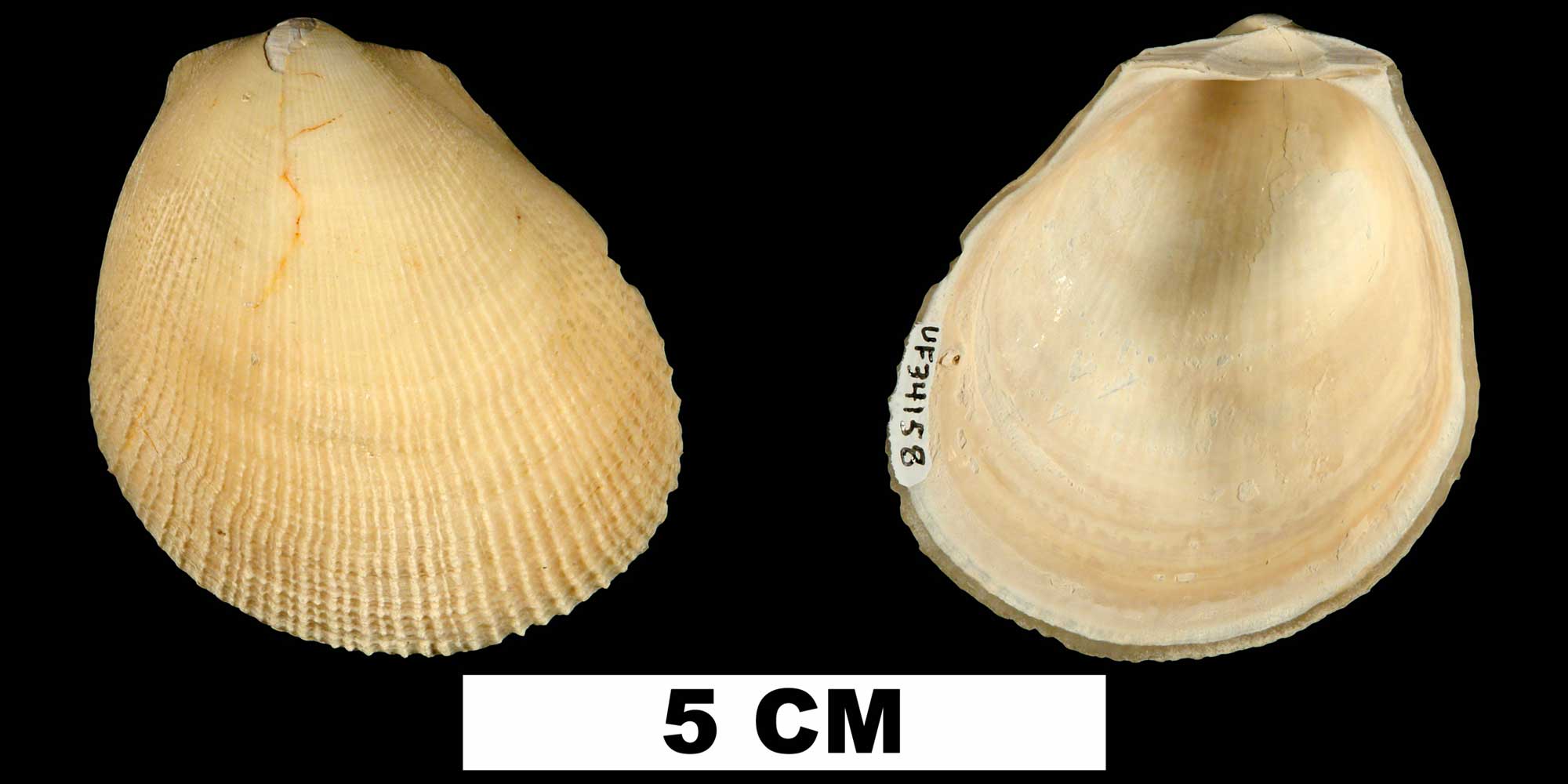
Order Limida. Limaria caloosana from the Plio-Pleistocene (formation unknown) of Sarasota County, Florida (UF 34158). Image from the Neogene Atlas.

Order Myalinida. Inoceramus barabini from the Pierre Shale of Niobrara County, Wyoming (YPM 35475). Image from the Neogene Atlas.
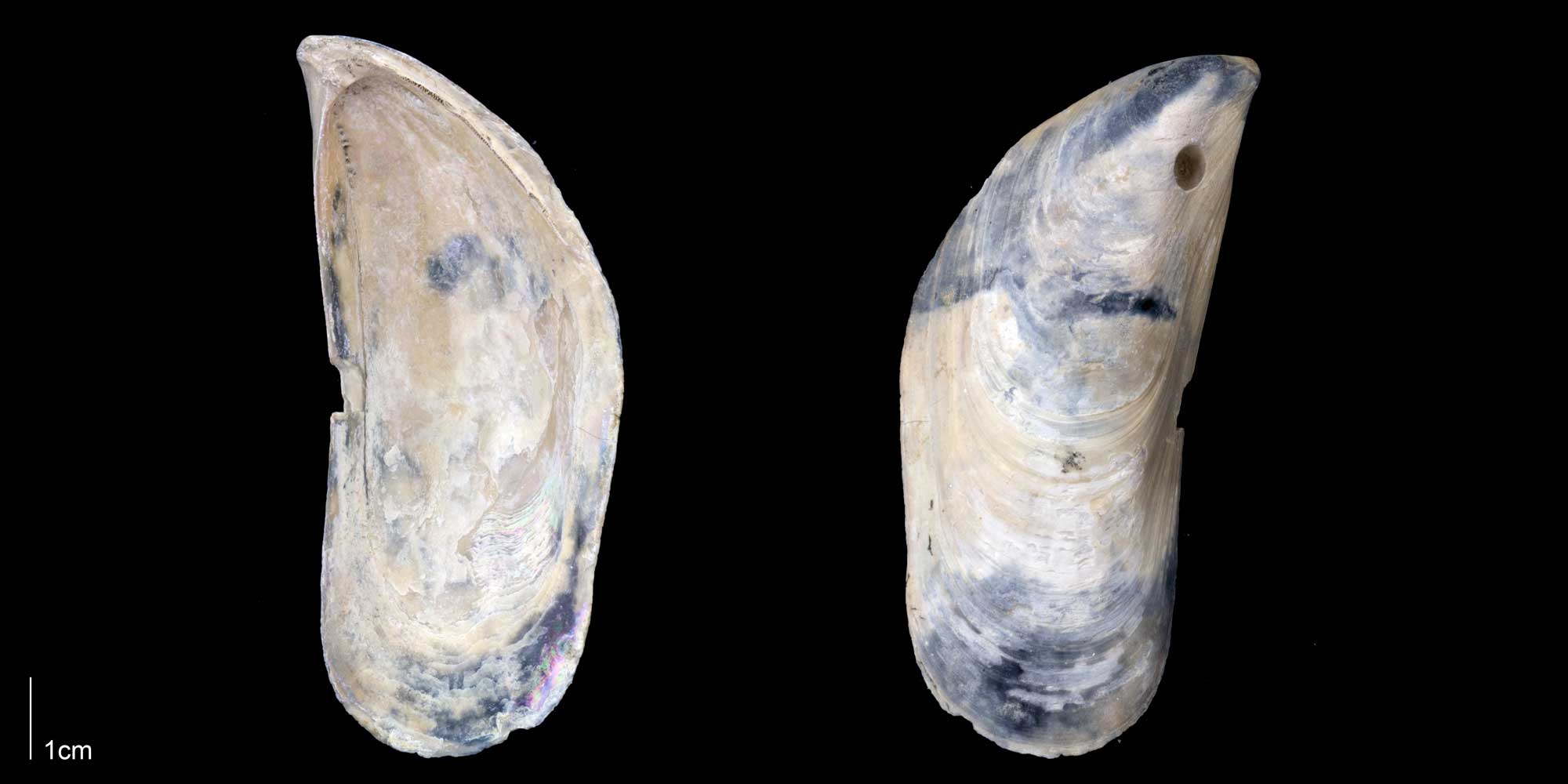
Order Mytilida. Perna conradiana from the Late Pliocene Tamiami Fm. (Pinecrest Beds) of Sarasota County, Florida (PRI 70164). Image from the Neogene Atlas.
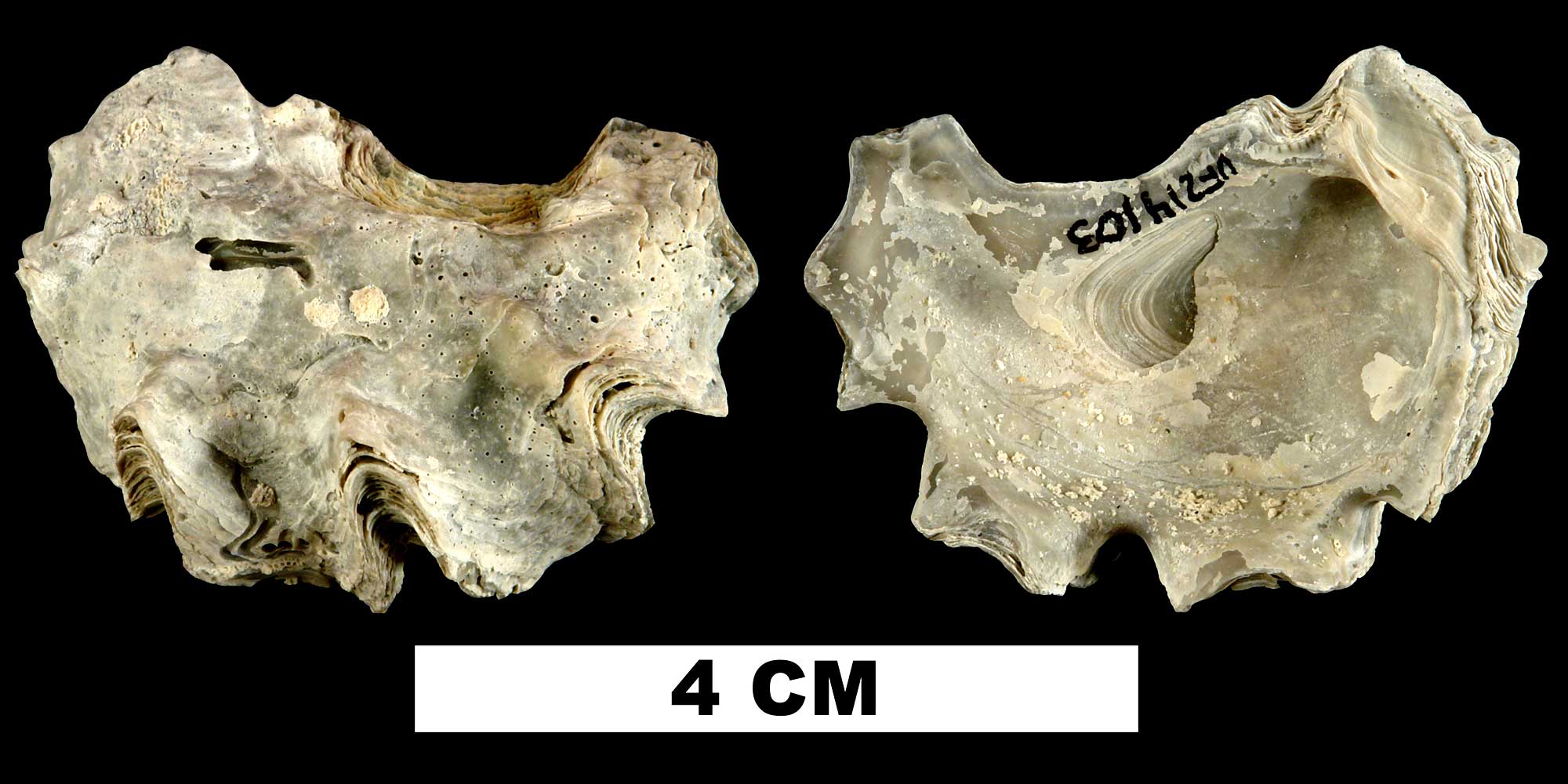
Order Ostreida. Ostrea locklini from the Late Pliocene Tamiami Fm. (Pinecrest Beds) of Okeechobee County, Florida (UF 214103). Image from the Neogene Atlas.
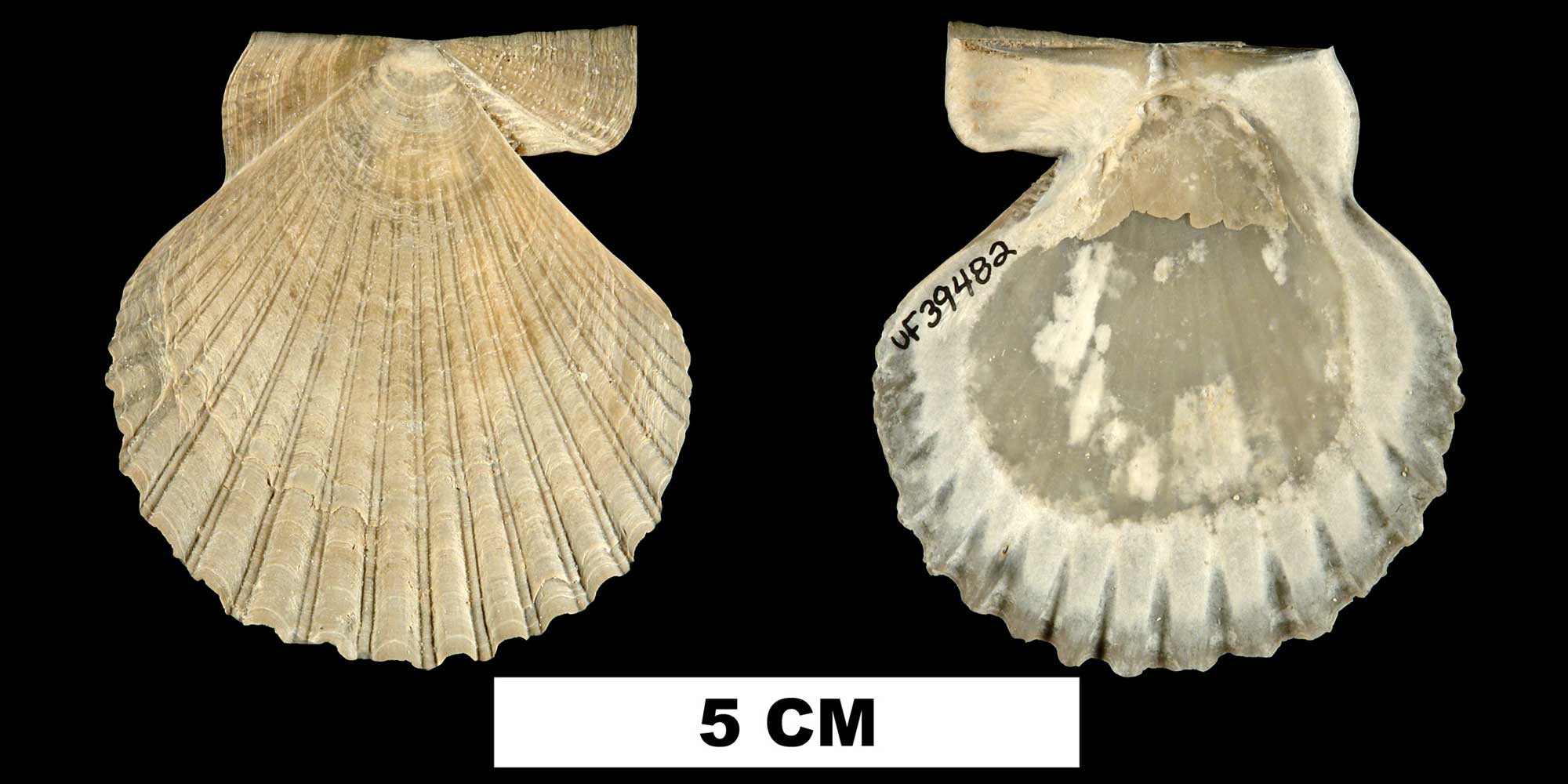
Order Pectinida. Interchlamys interlineata from the Late Pliocene Tamiami Fm. of Charlotte County, Florida (UF 39482). Image from the Neogene Atlas.
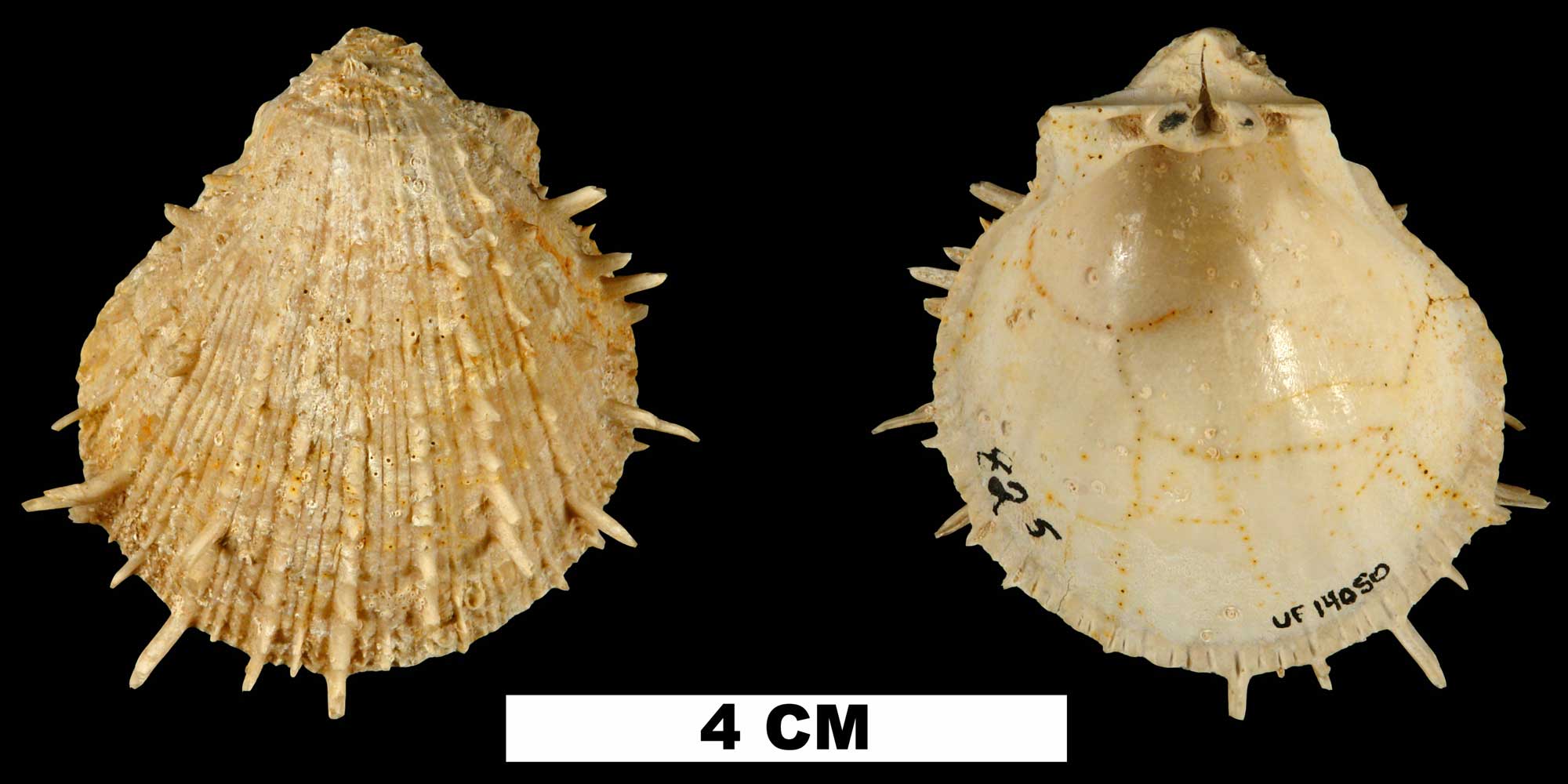
Order Pectinida. Spondylus chipolanus from the Early Miocene Chipola Fm. of Calhoun County, Florida (UF 14050). Image from the Neogene Atlas.
Infraclass Heteroconchia, Cohort Paleoheterodonta
Freshwater Mussels and relatives. Shells thickly nacreous and aragonitic, with few hinge teeth.
Paleoheterodonta Example 1: Trigoniids
Trigoniids were diverse and widespread in the Mesozoic, but are today limited to a single genus, Neotrigonia, which is found only around Australia. Neotrigonia is considered a living fossil; learn more here.
Fossil specimen of the bivalve Trigonia costata from the Jurassic of Germany (PRI 55092). Specimen is from the collections of the Paleontological Research Institution, Ithaca, New York. Longest dimension of specimen is approximately 8 cm (Sketchfab; CC0 public domain).
Paleoheterodonta Example 2: Freshwater Mussels
The exteriors of freshwater mussels are brown or yellow and have a thick, glossy periostracum. The inner surfaces of their shells are nacreous (a source of natural and cultured pearls, and pearl buttons historically) and are edentulous or feature heavy hinge teeth. Freshwater mussels have complex life cycles with parasitic (on fish) glochidia larvae.
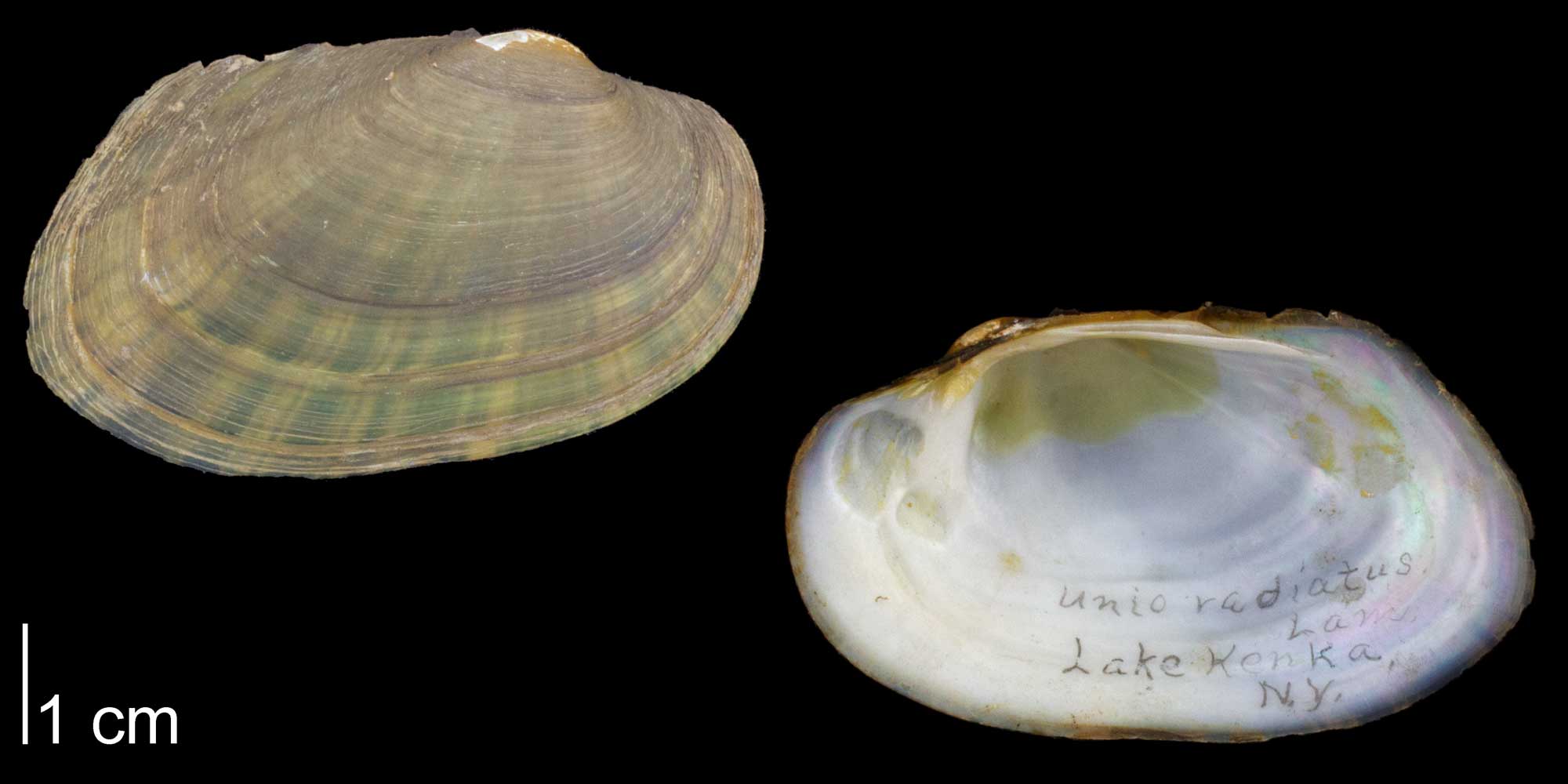
Valve of the freshwater mussel Lampsilis radiata. Specimen is from Lake Kenka, N.Y. (PRI 70362).
Orders of Paleoheterodonta (with additional resources):
- Trigoniida (WoRMS; Pennsylvanian Atlas [as Trigonioida]; Cretaceous Atlas; FossilWorks)
- Unionida (WoRMS; FossilWorks)
Additional Examples of Paleoheterodonta
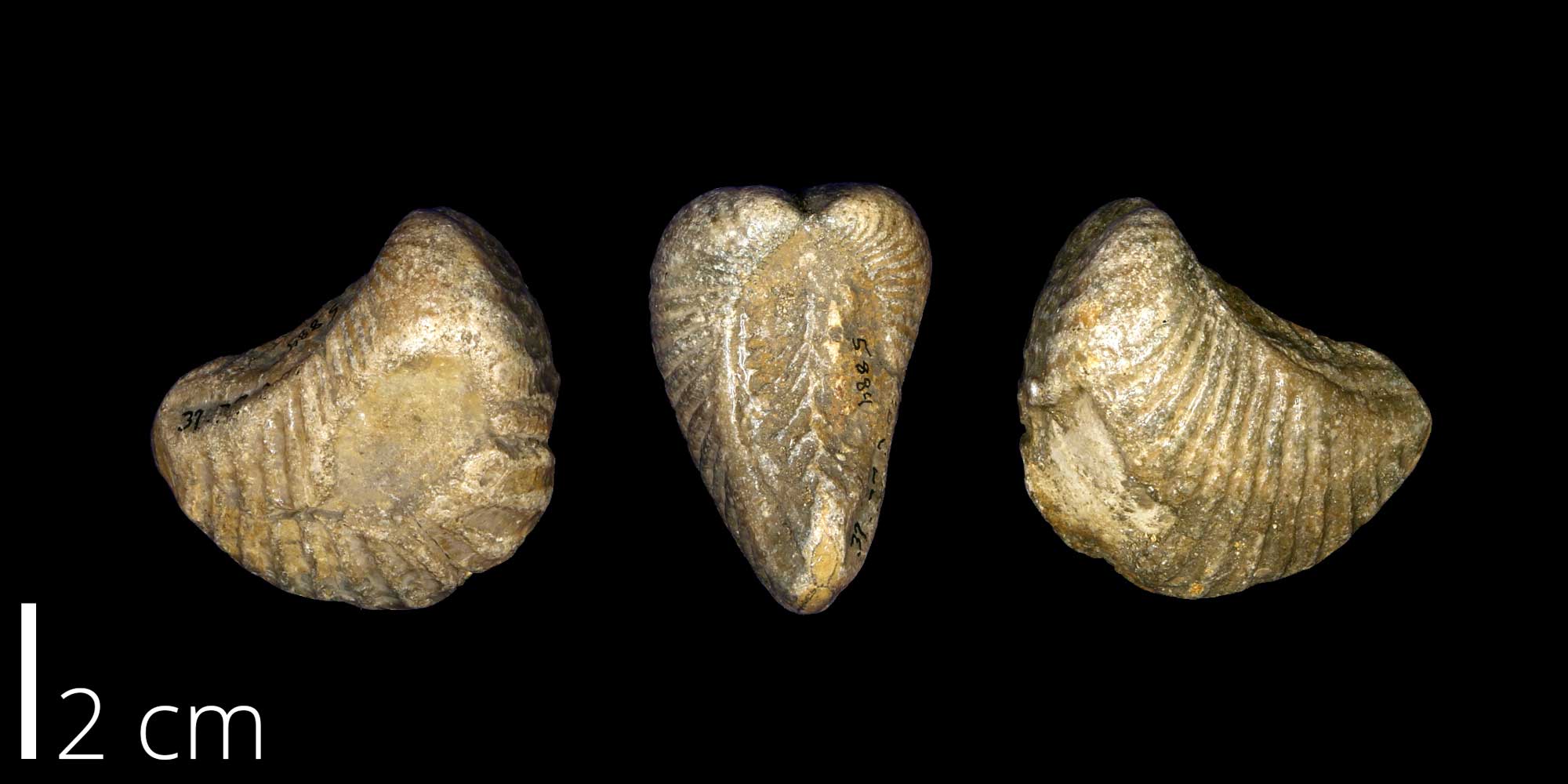
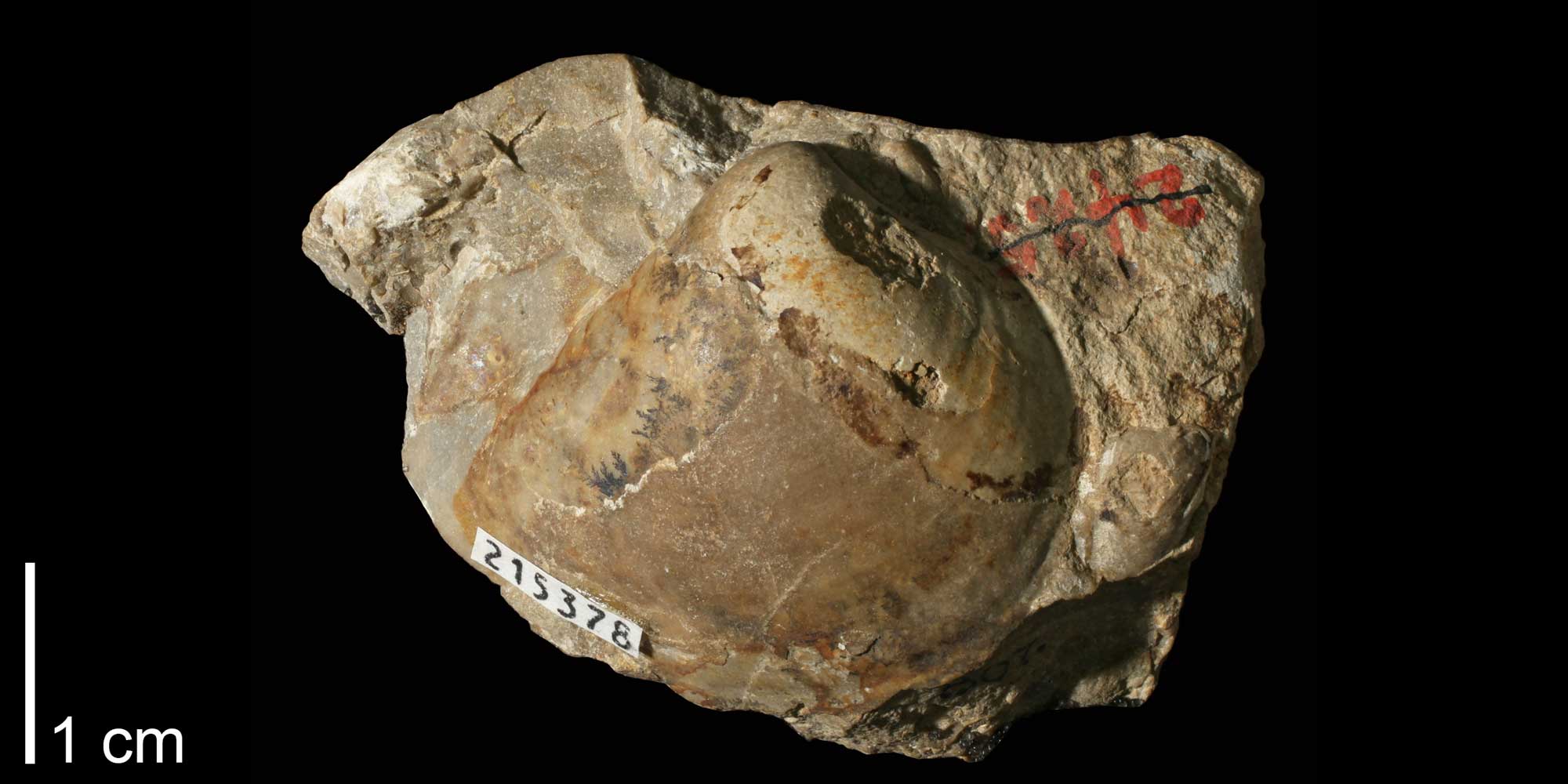
Order Trigoniida. Schizodus rossicus from the Coal Measures of Jackson County, Missouri (KUMIP 215378). Image from the Pennsylvanian Atlas.
Infraclass Heteroconchia, Cohort Heterodonta
The two subcohorts of this group are divided largely on the basis of molecular studies. Heterodonts generally have equally sized valves, heterodont hinges (few cardinal teeth, long lateral teeth), and lack nacre.
Subcohort Archiheterodonta
“Primitive Heterodonts.” Archiheterodonts are all marine and lack a siphon. This group consists of numerous families of extinct actinodonts plus the Recent order Carditida. Carditids include the diverse and abundant marine families Carditidae, Crassatellidae, and Astartidae.
Orders of Archiheterodonta (with additional resources):
- Actinodontida† (Ordovician Atlas; FossilWorks)
- Carditida (WoRMS; Cretaceous Atlas; Neogene Atlas; FossilWorks)
Examples of Archiheterodonta
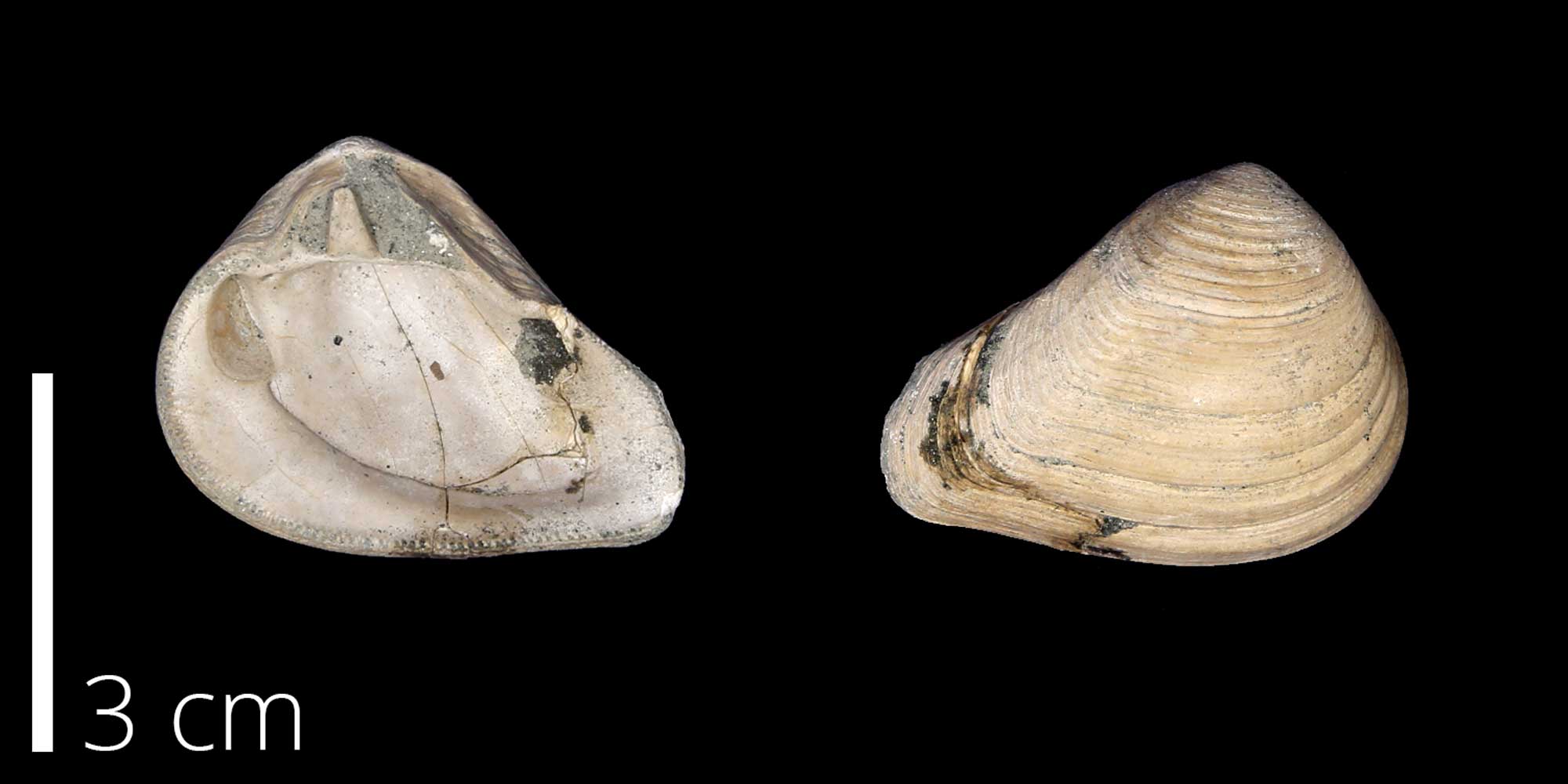
Order Carditida (Family Crassatellidae). Crassatella vadosa from the Maastrichtian Owl Creek Fm. of Tippah County, Mississippi (UNM 14864). Image from the Cretaceous Atlas.

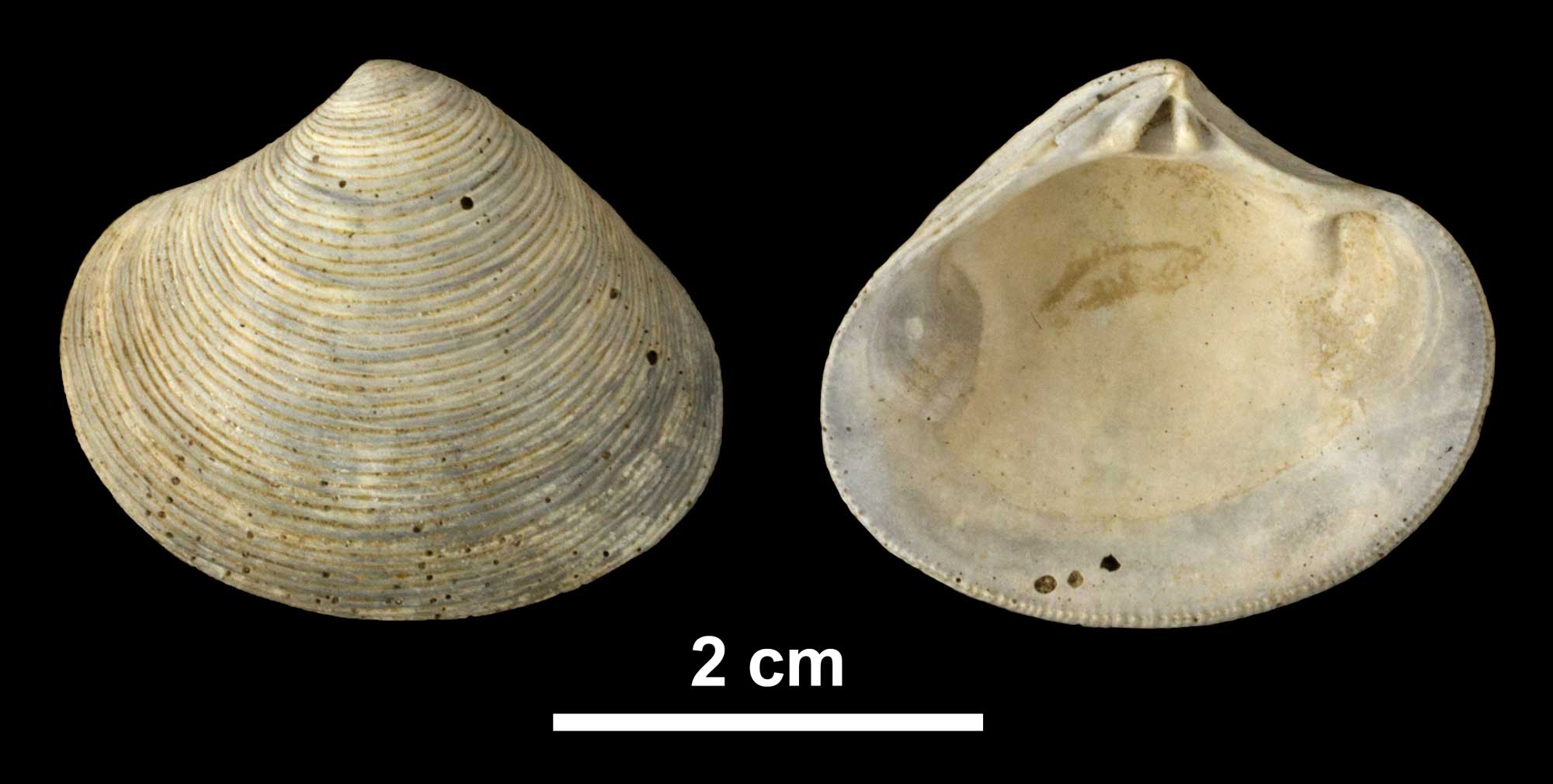
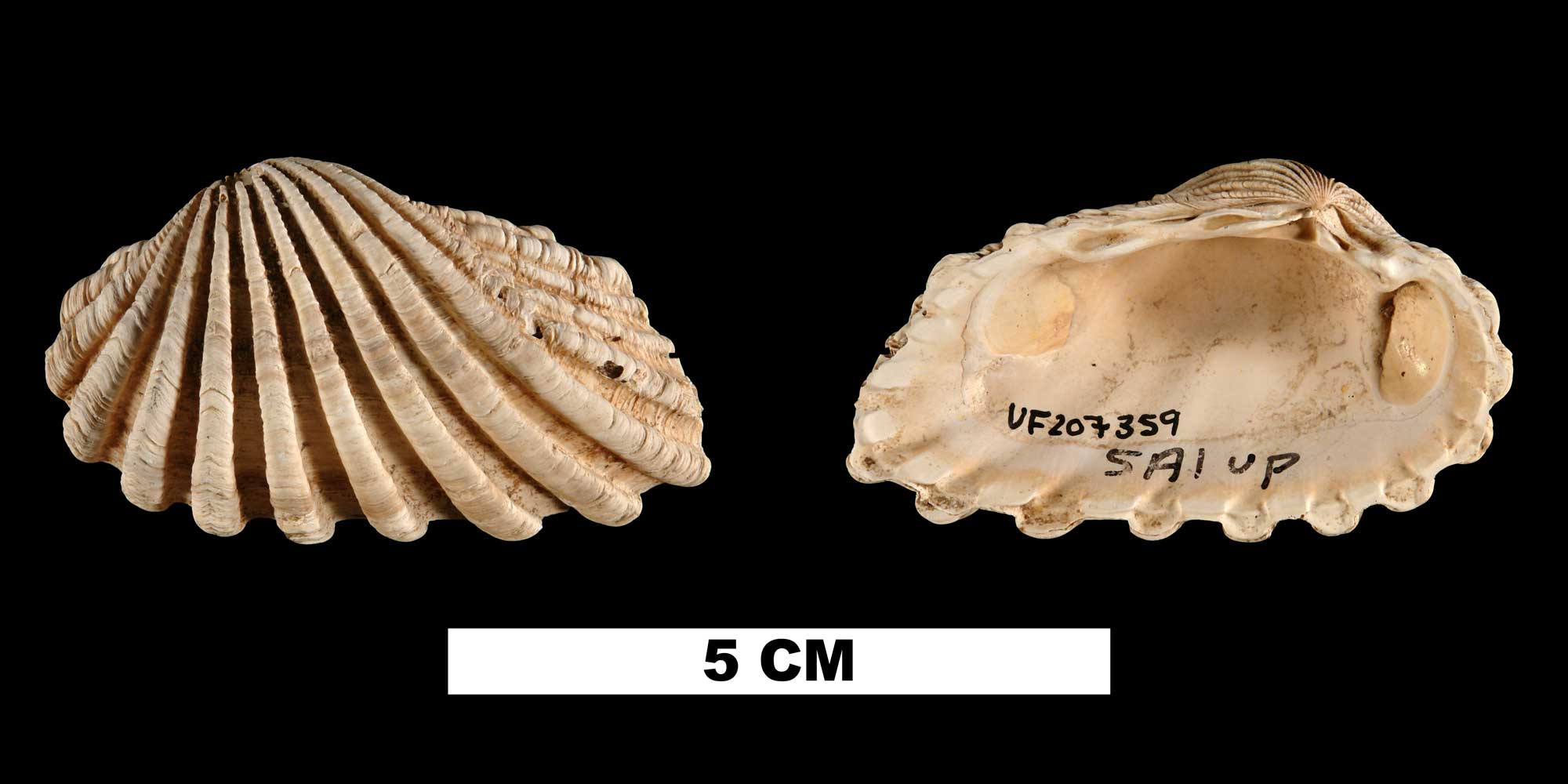
Subcohort Euheterodonta
“True Heterodonts.” This hyperdiverse group includes all remaining bivalves. Most have a siphon.
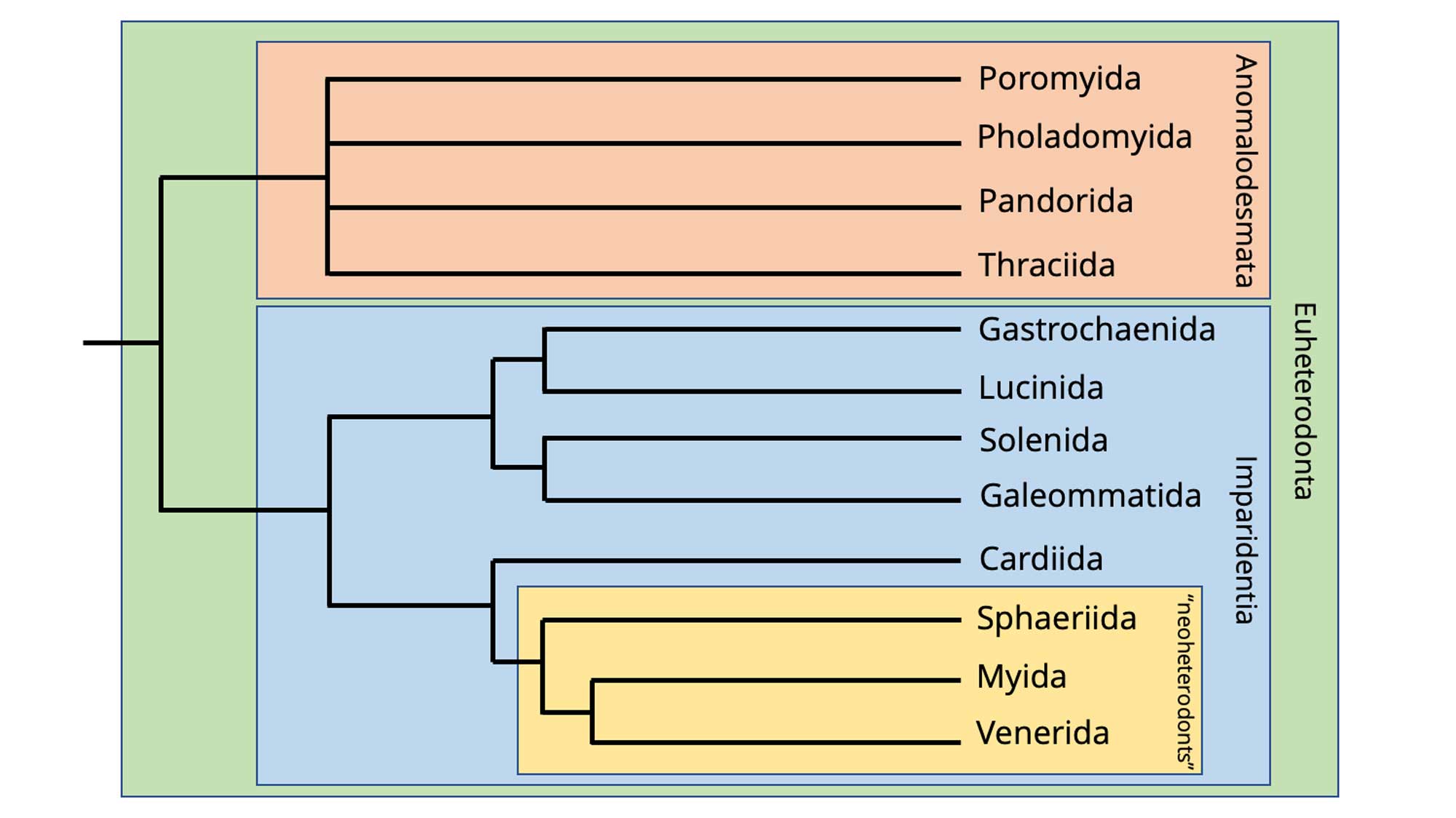
Simplified phylogeny of Recent euheterodont bivalves (based on Combosch et al., 2017).
Megaorder Anomalodesmata
Highly specialized bivalves lacking hinge teeth (or with secondarily derived teeth), mostly-fused mantle, periostracum with calcareous spicules, and prismatonacreous shells. Clade includes the carnivorous bivalve genus Poromya, which has very reduced “septibranch” gills and a septum that creates a pump to suck prey into an enlarged, eversible incurrent siphon; a reduced, cuticle-lined stomach is modified for crushing thin-shelled prey.
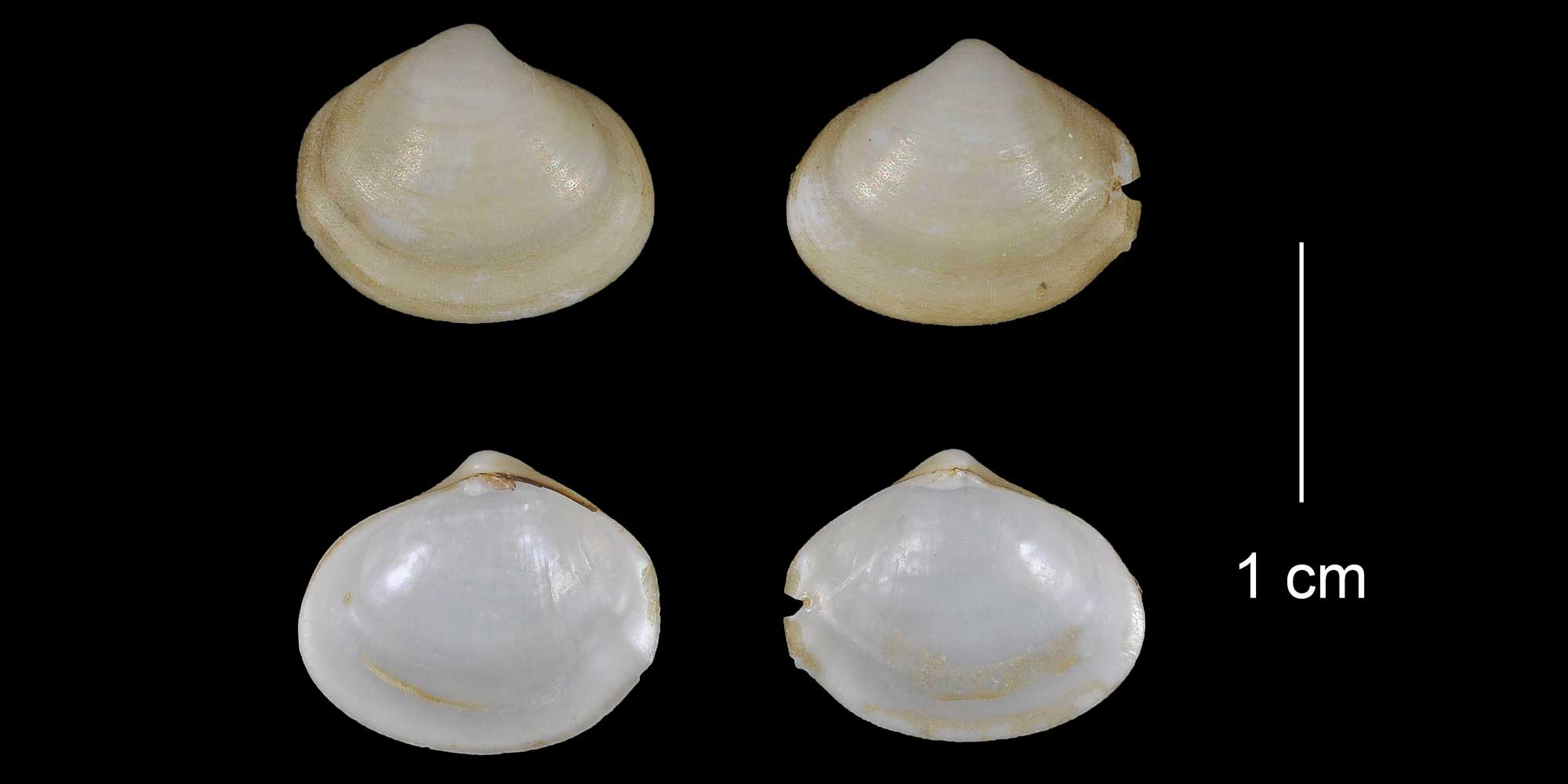
Holotype of Poromya houbricki Bernard, 1989 (USNM 222378). Image from the Smithsonian Institution (GBIF; Creative Commons 0 license).
Orders of Anomalodesmata (with additional resources):
- Pandorida (Cretaceous Atlas; FossilWorks)
- Pholadomyida (WoRMS [as Anomalodesmata]; Ordovician Atlas; Pennsylvanian Atlas [as Pholadomyoida]; Cretaceous Atlas; FossilWorks)
- Poromyida (Cretaceous Atlas; FossilWorks)
- Thraciida (FossilWorks)
Examples of Anomalodesmata
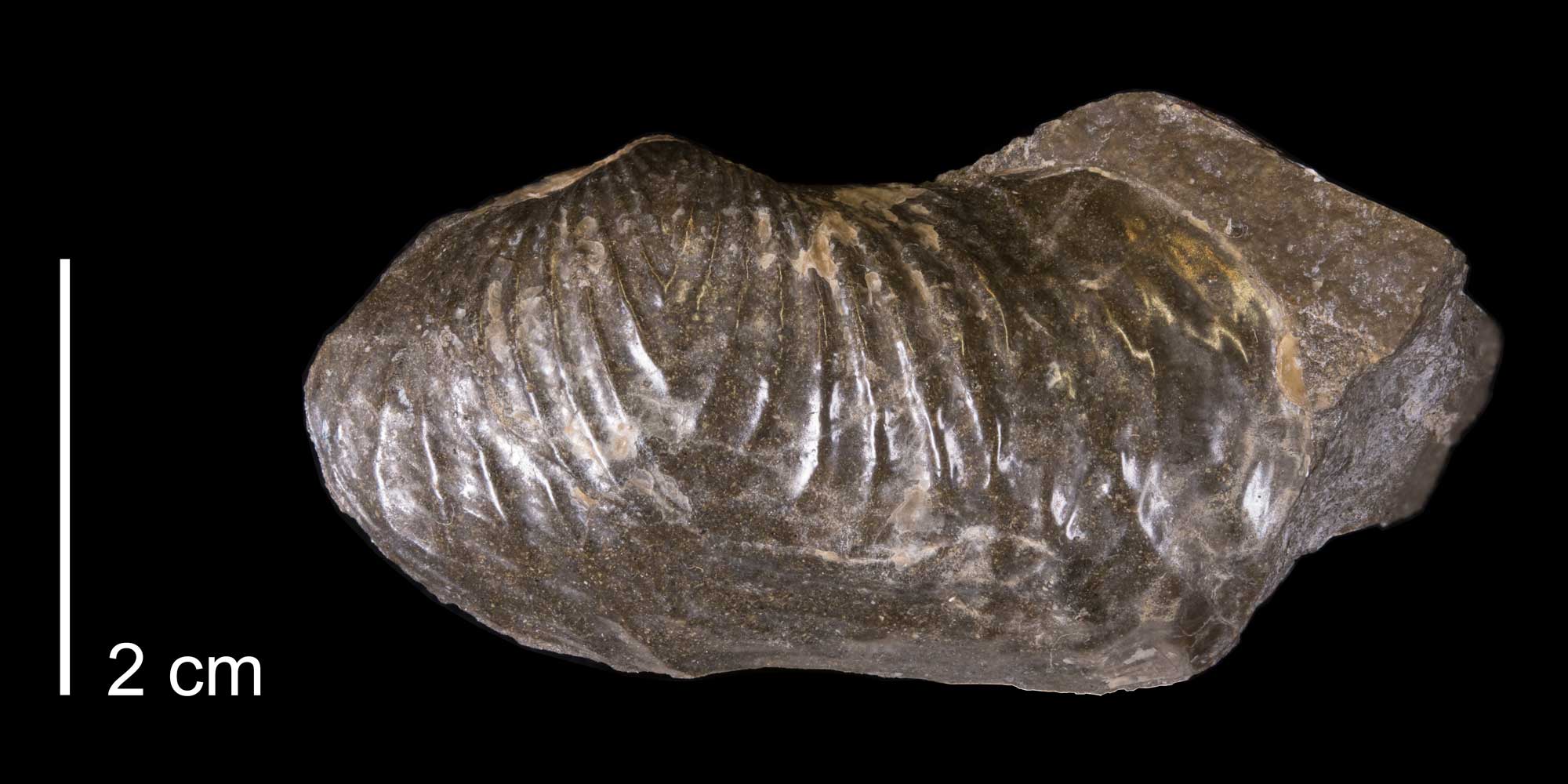
Order Pholadomyida. Goniomya americana from the Fox Hills Formation of Dewey County, South Dakota (YPM 24148). Image from the Cretaceous Atlas.
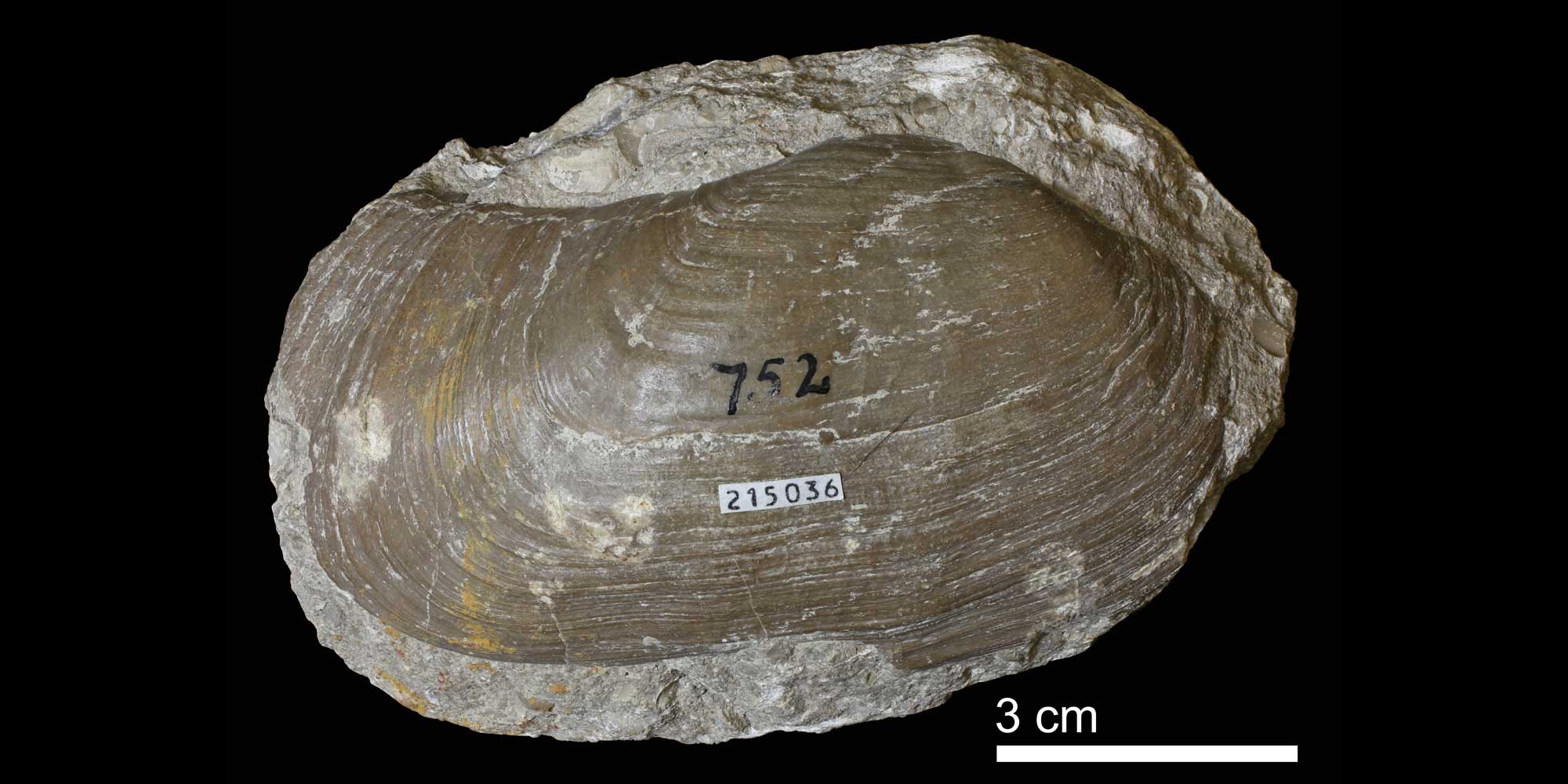
Order Pholadomyida. Chaenomya sp. from the Drum Limestone of Montgomery County, Kansas (KUMIP 215036). Image from the Pennsylvanian Atlas.
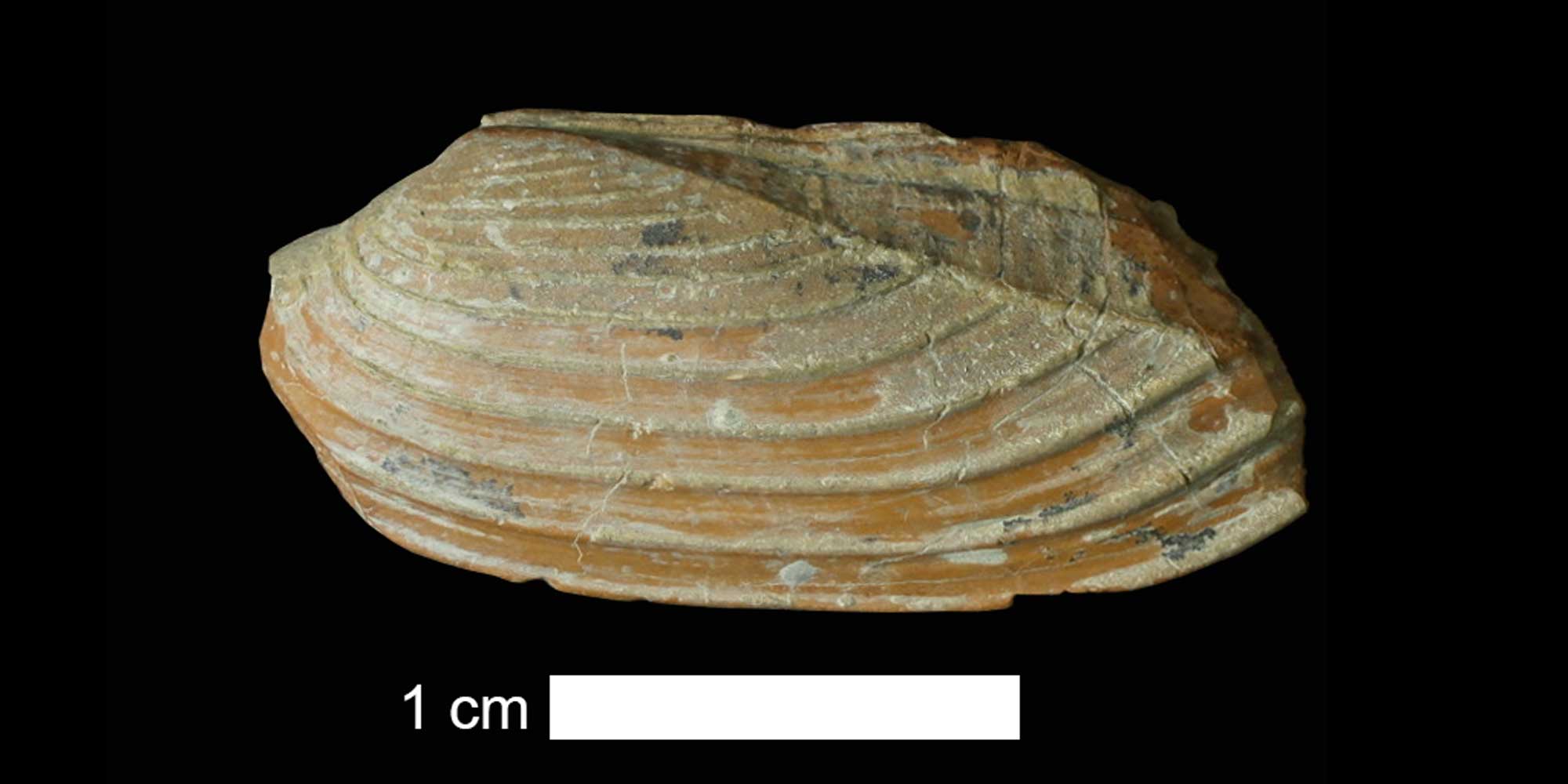
Order Pholadomyida. Sanguinolites sp. from the Keechi Creek Fm. of Palo Pinto County, Texas (KUMIP 260902). Image from the Pennsylvanian Atlas.

Order Poromyida. Cardiomya anaticepsella from the Eocene Keasey Fm. of Oregon. Length is 10.5 mm. Image from Hickman (2014), provided courtesy of Carole Hickman.
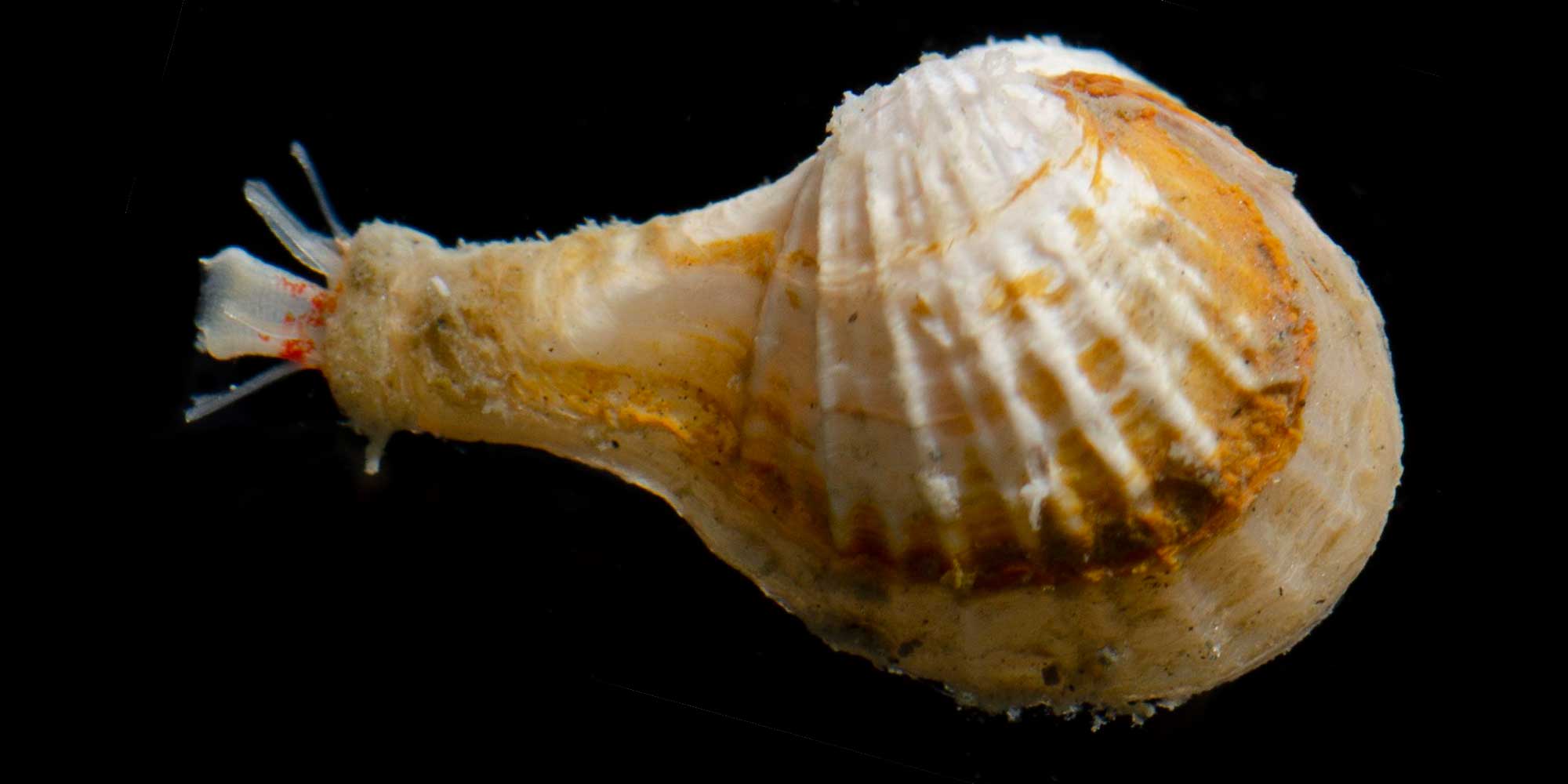
Order Poromyida. Cardiomya pectinata from the Recent of Whatcom Bellingham Bay, Pt. Frances (Portage Is.), Washington. Image is from the Florida Museum of Natural History Division of Invertebrate Zoology (GBIF; Creative Commons Attribution-NonCommercial 4.0 International license; image slightly widened).
Megaorder Imparidentia
The largest group of living bivalves, most of which are infaunal.
Imparidentia Example 1: Mercenaria.
See the first page of this chapter to learn more about the morphology of Mercenaria.
Fossil specimen of the bivalve Mercenaria mercenaria from the Quaternary of St. Mary’s County, Maryland (PRI 76728). Specimen is from the collections of the Paleontological Research Institution, Ithaca, New York. Width of specimen is approximately 10 cm. Click here for a view showing both valves together. Model from the Digital Atlas of Ancient Life (Sketchfab; Creative Commons 0 license).
Imparidentia Example 2: Teredo (Shipworm)
Bivalves in the genus Teredo have a long, worm-like body and live within a secreted calcareous tube in wood; they have a small shell modified for rasping and are one of the few invertebrates that are able to digest cellulose.
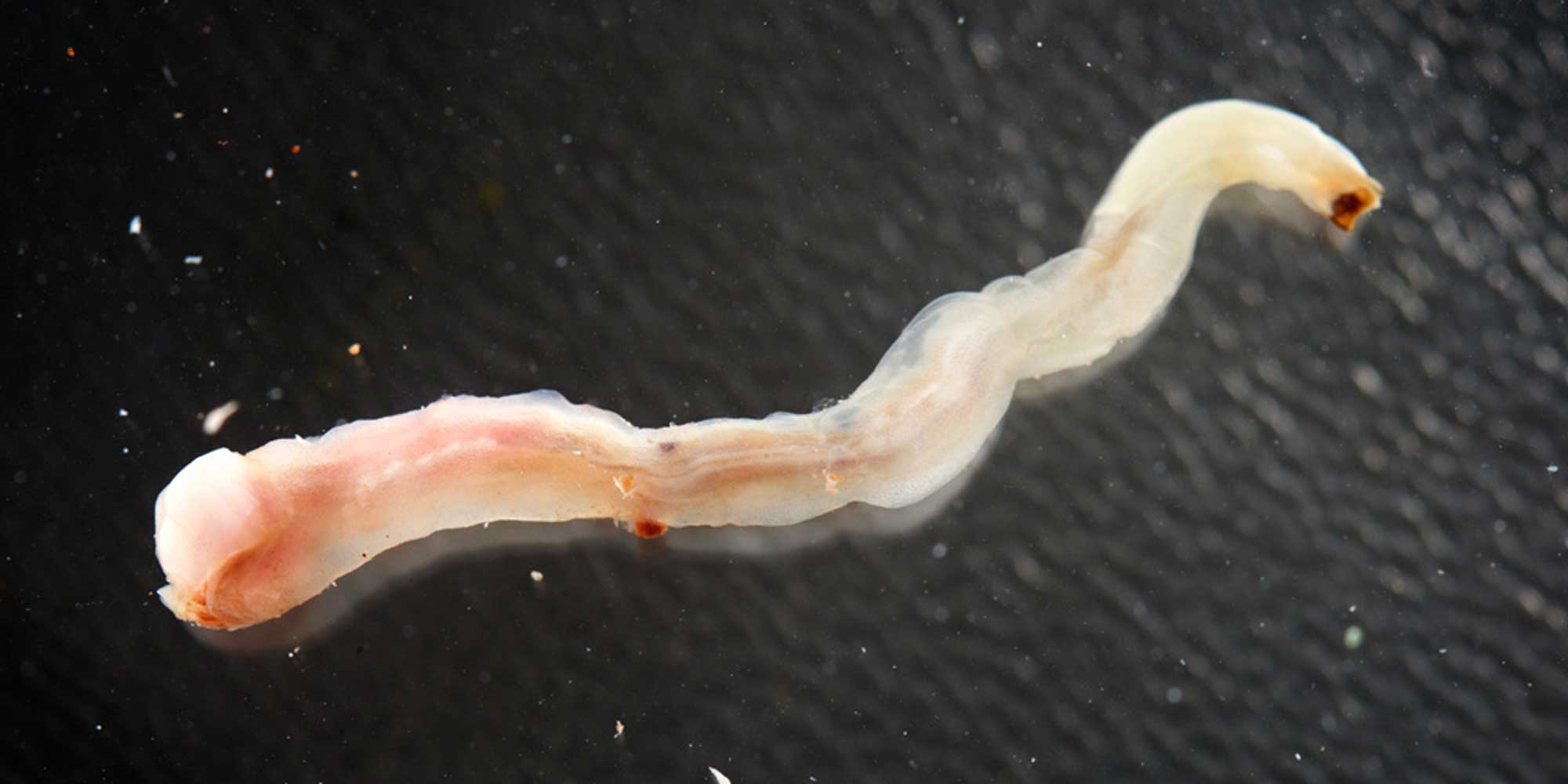
The shipworm Teredo clappi removed from its tube. Image is from the Museum of Comparative Zoology, Harvard University (GBIF; Creative Commons Attribution-NonCommercial-ShareAlike 3.0 Unported license; image trimmed).
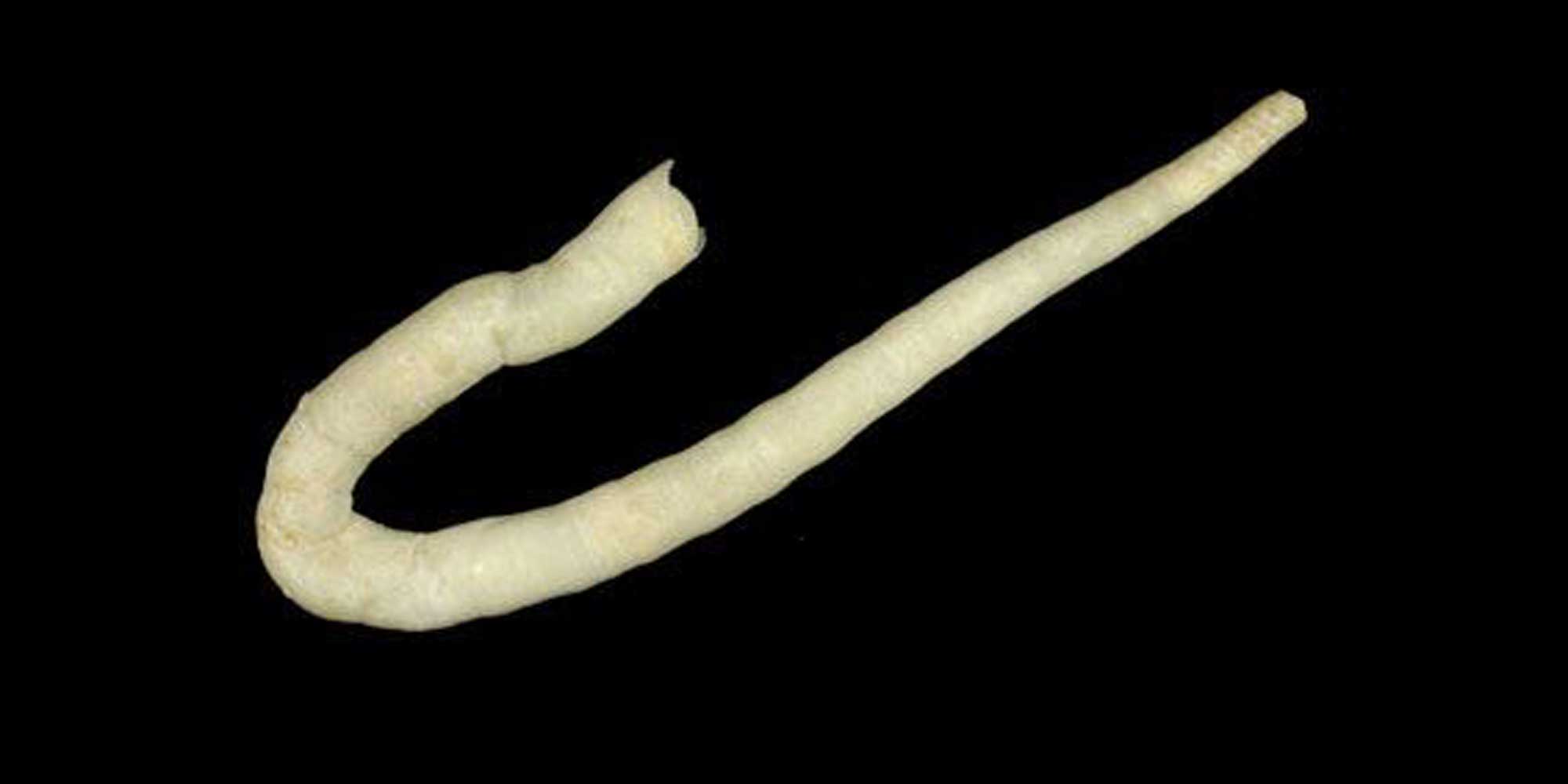
Tube of Teredo navalis from Spain, Canarias Lanzarote, Puerto del Carmen; NMR 37462. Total length of tube 200 mm. Image by Joop Trausel and Frans Slieker, Collection of the Natural History Museum of Rotterdam (GBIF; Creative Commons Attribution 4.0 International license; image dimensions changed and label transcribed here).
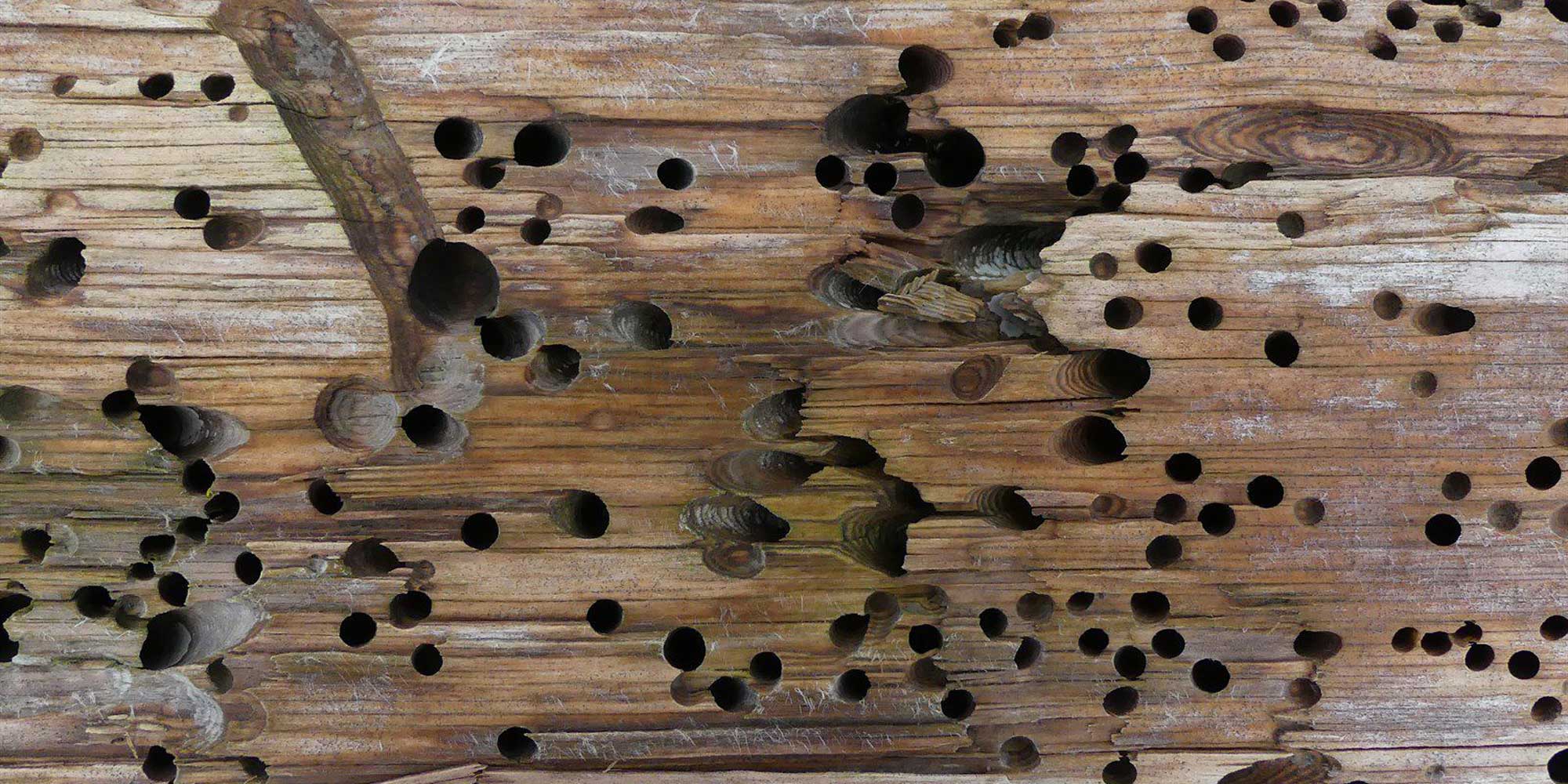
Teredo borings in wood. Image by Terje O. Nordvik (GBIF; Creative Commons Attribution-NonCommercial-ShareAlike 4.0 International license; image trimmed).
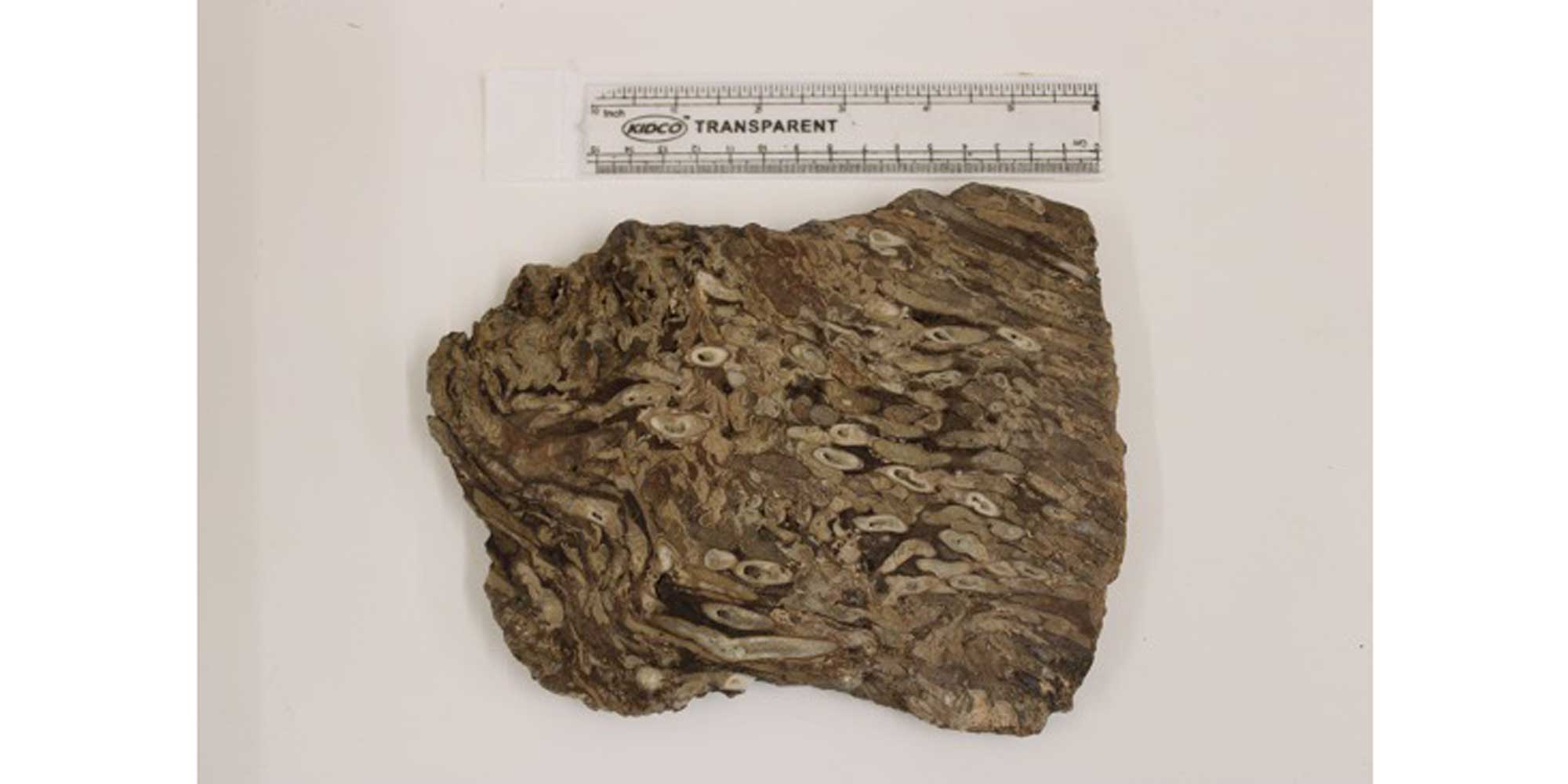
Wood bored by Teredo sp. from the Pliocene of San Benito Co., California (PRI K21009).
Individuals of the trace fossil Teredolites, which are borings made in fossil wood by Teredo (PRI 61842); specimen is from the Paleocene Lopez de Bertodano Fm. of Seymour Island, Antarctica. Fossil is part of the research collections of the Paleontological Research Institution, Ithaca, New York. Length of rock is approximately 16.5 cm. Model from the Digital Atlas of Ancient Life (Sketchfab; Creative Commons 0 license).
Imparidentia Example 3: Family Galeommatidae
The family Galeommatidae includes many species that are commensal with other invertebrates. Members of the family have a mantle that envelops an internalized shell and that is adorned with sensory papillae and tentacles. Members also have a crawling foot and many brood larvae in their gills.
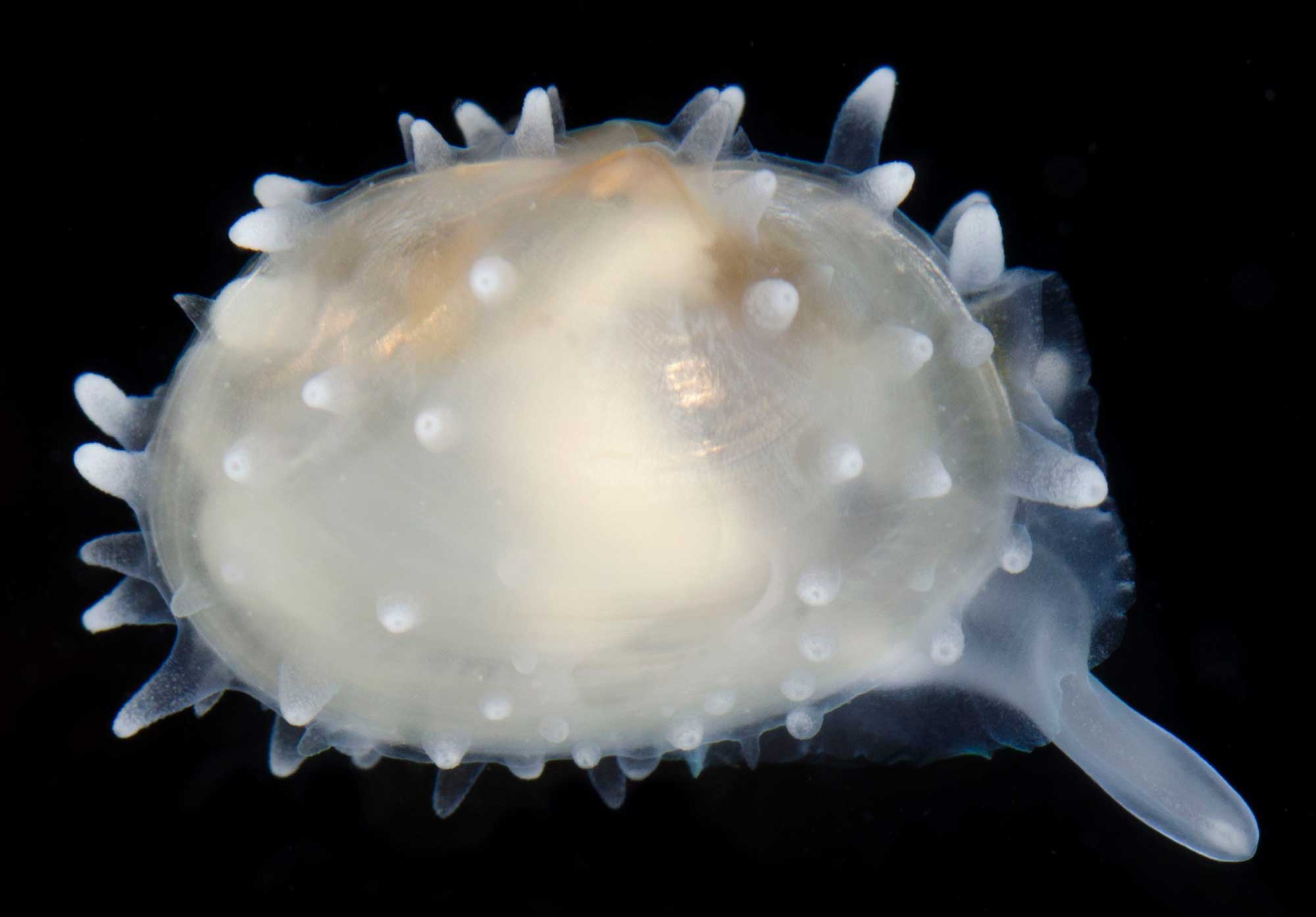
Scintilla violescens, a member of the family Galeommatidae. Specimen is from Hong Kong. Photograph by the Florida Museum of Natural History Division of Invertebrate Zoology (GBIF; Creative Commons Attribution-NonCommercial 4.0 International license).
Imparidentia Example 4: Rudists (Extinct)
Rudist bivalves are extinct (Jurassic-Cretaceous) bivalves with inequally-sized valves that formed a tube and cap. They were important reef-building animals during the Cretaceous, temporarily filling a niche that had instead been occupied by corals during much of the Phanerozoic.
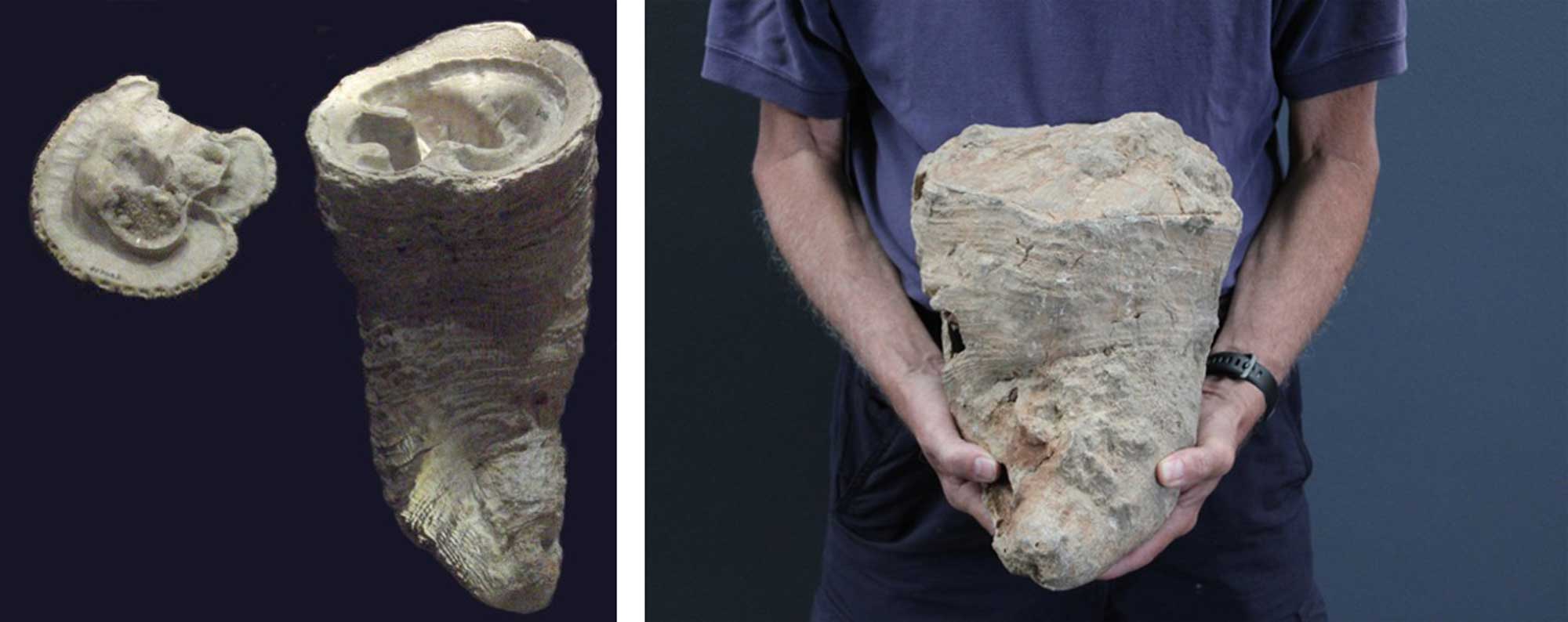
Rudist bivalves. Left: Hippurites radiosus from the Late Cretaceous of France. Specimen in the collection of the National Museum of Natural History, Smithsonian Institution. Specimen is about 10 cm tall. Photo by Warren Allmon. Right: Dictyoptychus persica from the Late Cretaceous of Iran (PRI 41794). Photo courtesy of Warren Allmon.
Fossil specimen of the rudist bivalve Hippurites radiosus from the Cretaceous of Dordogne, France (PRI 80129). Specimen is from the research collections of the Paleontological Research Institution, Ithaca, New York. Length of specimen is 21 cm. Model by Digital Atlas of Ancient Life (Sketchfab; Creative Commons 0 license).
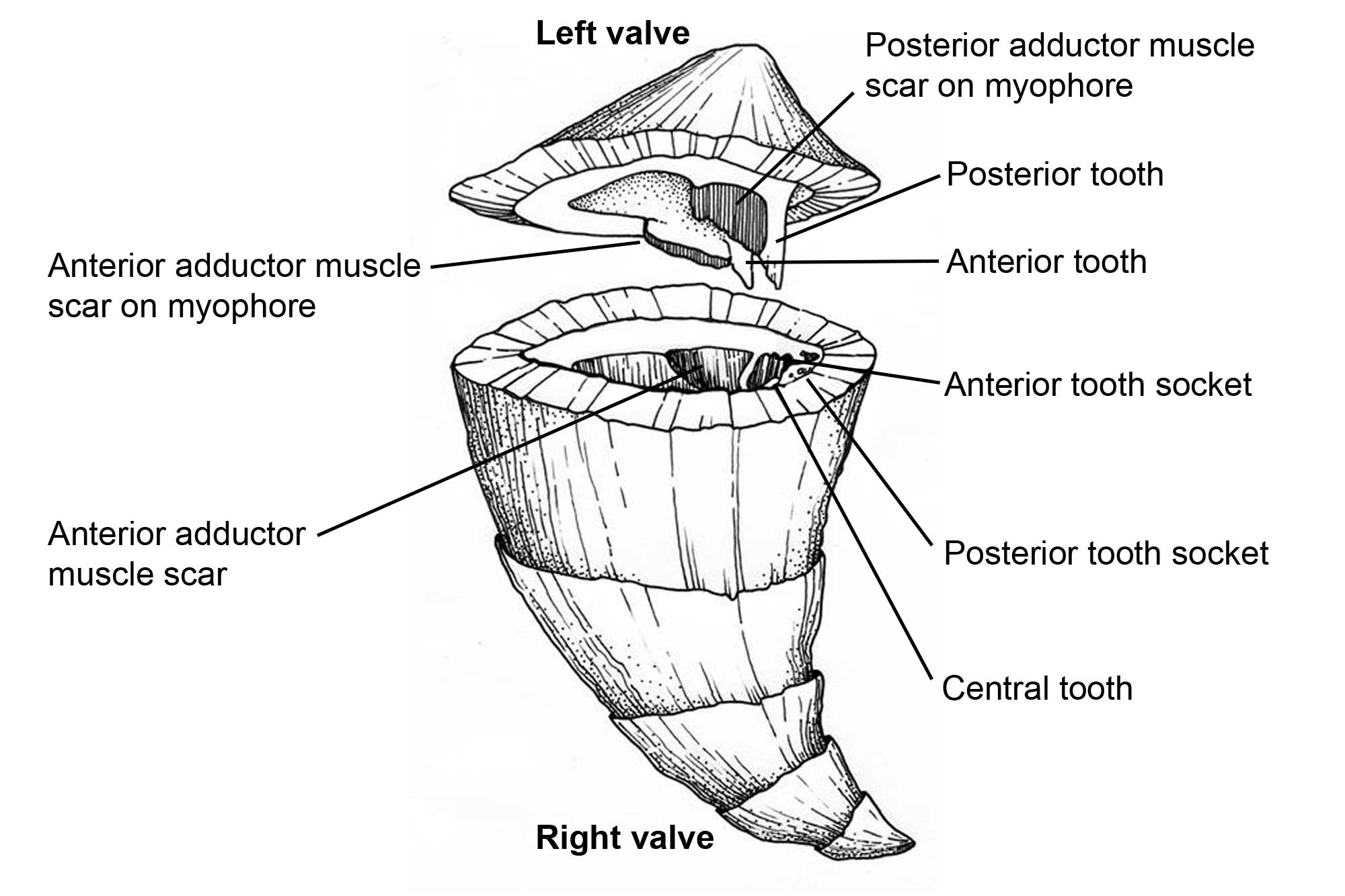
Diagram of rudist morphology, based on the genus Radiolites. The left (free) valve is shown above the right (attached) valve. Drawing by Christi Sobel (based on Skelton, 1979).
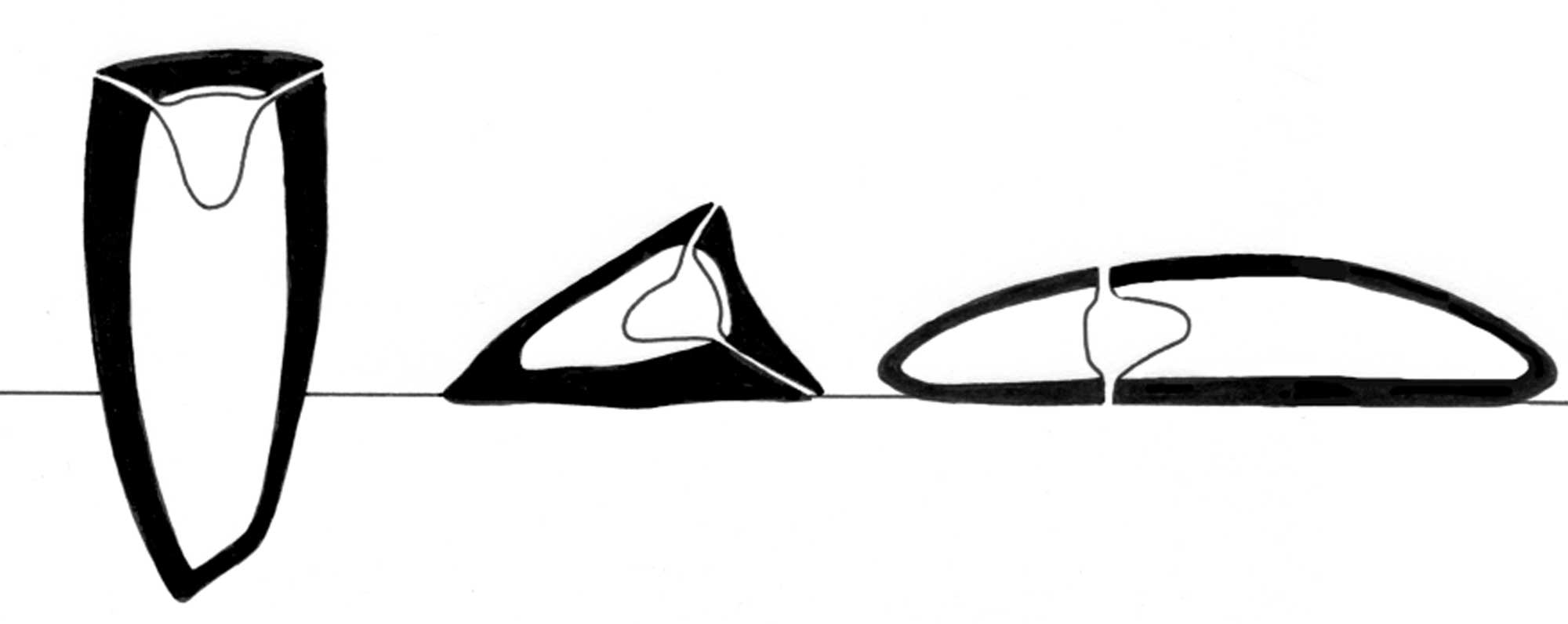
The three rudist morphotypes: left, elevator; middle, clinger; and right, recumbent. Drawing by Christi Sobel (based on Gili and Götz, 2018).

Airport paleontology: Rudists in Cretaceous limestone tile flooring in the airport at Orlando, Florida. Photos by Warren Allmon.
Orders of Imparidentia (with additional resources):
- Cardiida (WoRMS, Cretaceous Atlas, Neogene Atlas [Cardiidae, Donacidae, Semelidae, Tellinidae], FossilWorks)
- Galeommatida (WoRMS)
- Gastrochaenida (WoRMS, Neogene Atlas [Lasaeidae], FossilWorks [as Gastrochaenidina)
- Hippuritida† [rudists] (Cretaceous Atlas, FossilWorks)
- Lucinida (WoRMS, Cretaceous Atlas, Neogene Atlas [Lucinidae], FossilWorks)
- Myida (WoRMS, FossilWorks [as Myoida])
- Sphaeriida
- Solenida (WoRMS [as Adapedonta], Cretaceous Atlas, Neogene Atlas [Hiatellidae, Pharidae], FossilWorks)
- Venerida (WoRMS, Pennsylvanian Atlas [as Veneroida], Cretaceous Atlas, Neogene Atlas [Chamidae, Mactridae, Ungulinidae, Veneridae], FossilWorks [as Veneroidei])
- Extinct superfamilies of uncertain relationships:
- Anthracosioidea† (FossilWorks)
- Grammysioidea† (FossilWorks)
- Modiomorphoidea† (Ordovician Atlas [as Modiomorphida], Pennsylvanian Atlas [as Modiomorphida], FossilWorks)
Additional Examples of Imparidentia
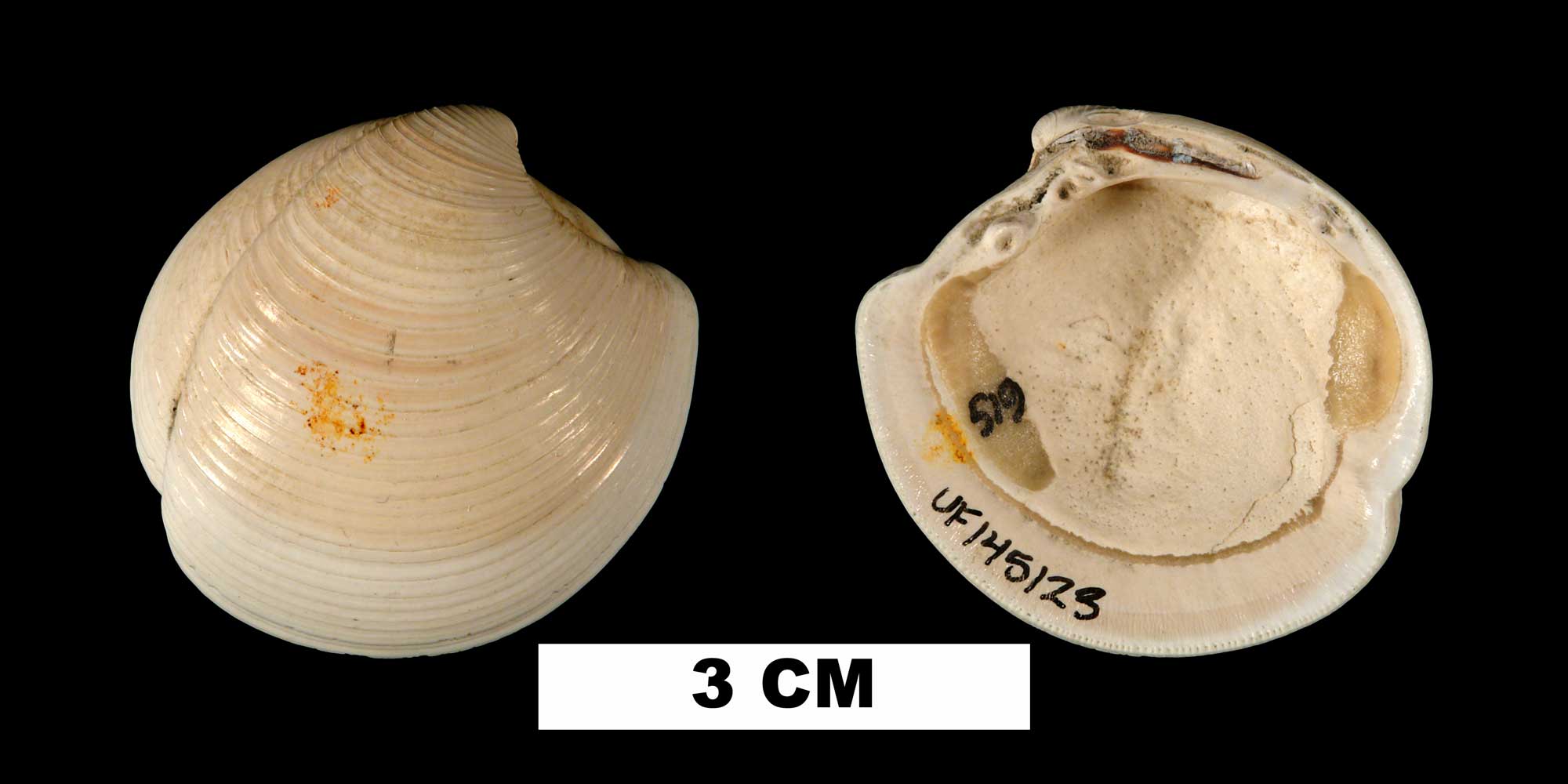
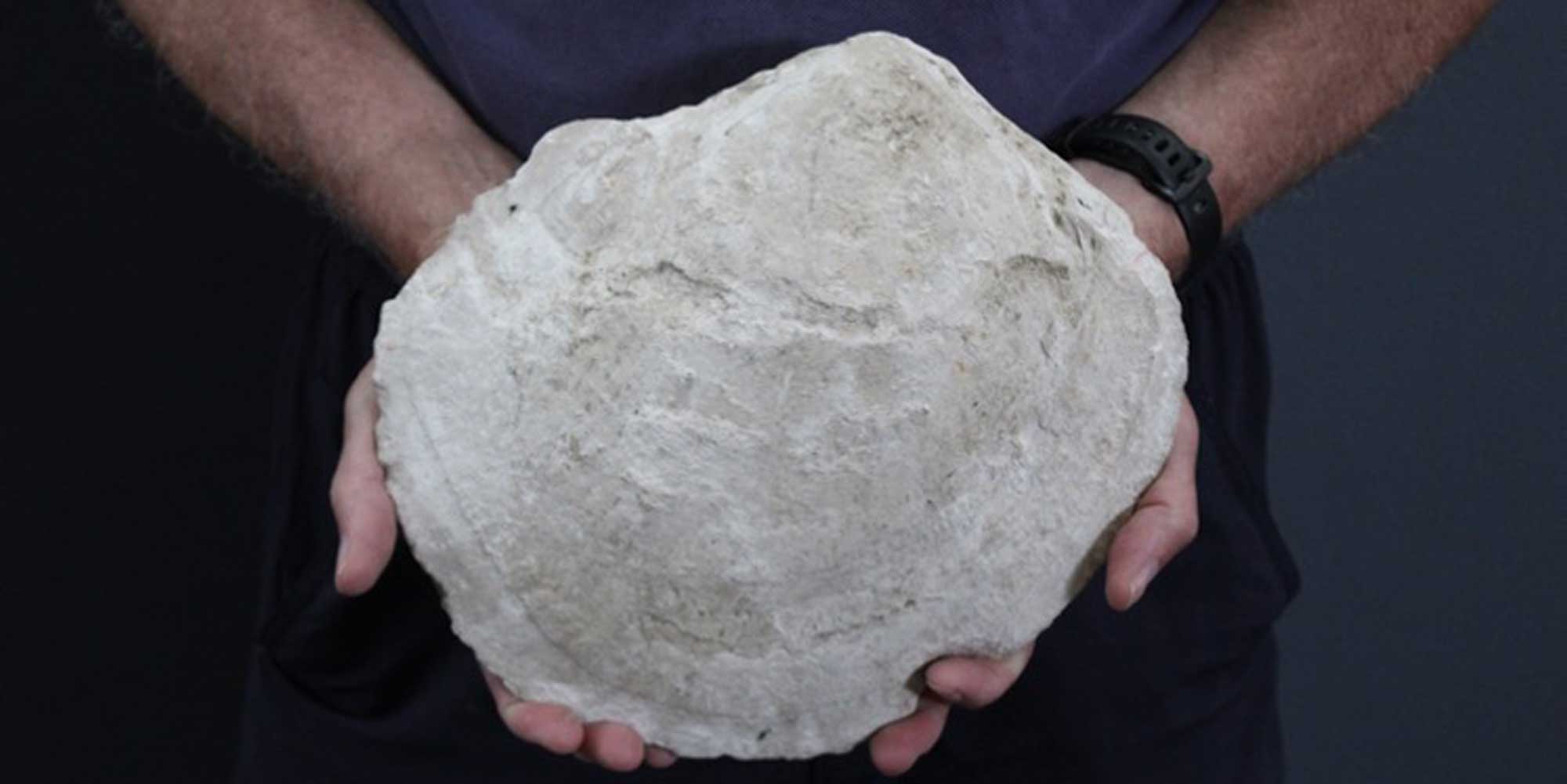
Order Lucinida (Family Lucinidae). Pseudomiltha megameris from the Eocene of Jamaica (PRI 49883). This internal mold represents one of the largest known members of this family.
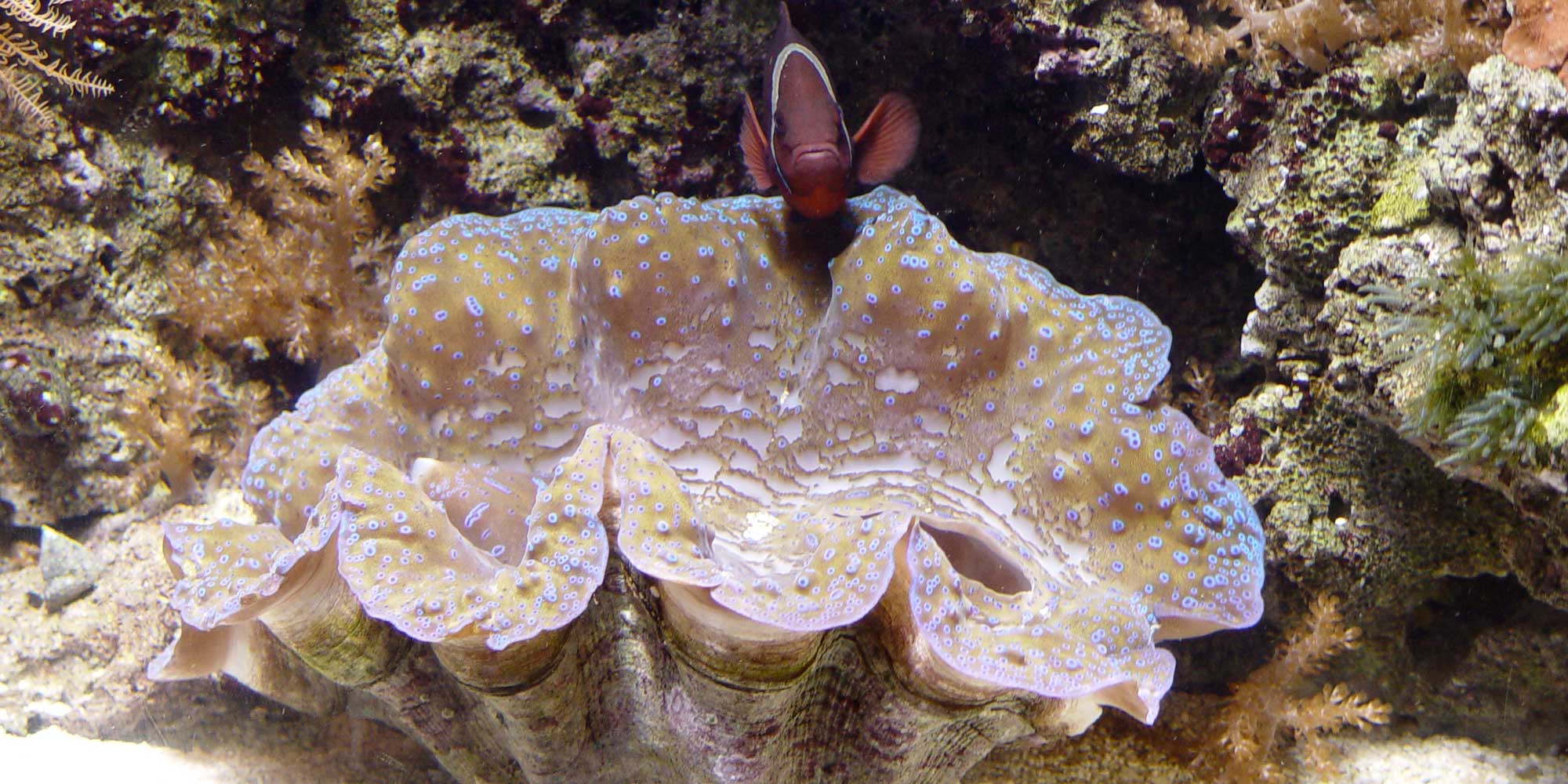
Order Cariida (Family Cardiidae). Live individual of the giant clam Tridacna sp. on display in an aquarium. Photograph by Jonathan R. Hendricks.
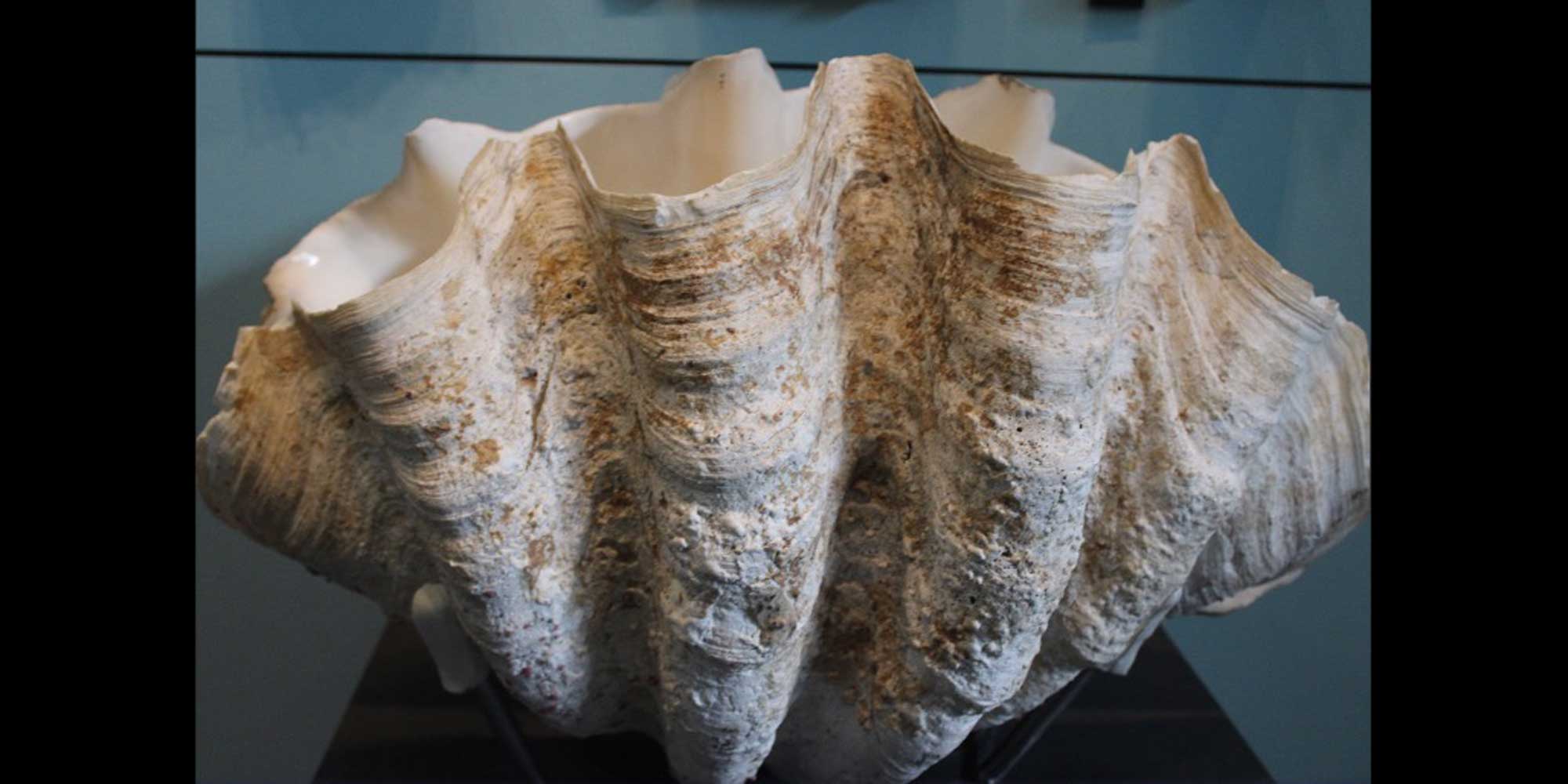
Order Cariida (Family Cardiidae). Recent specimen of the giant clam Tridacna gigas from Bikini Atoll on display at the Museum of the Earth, Ithaca, New York.
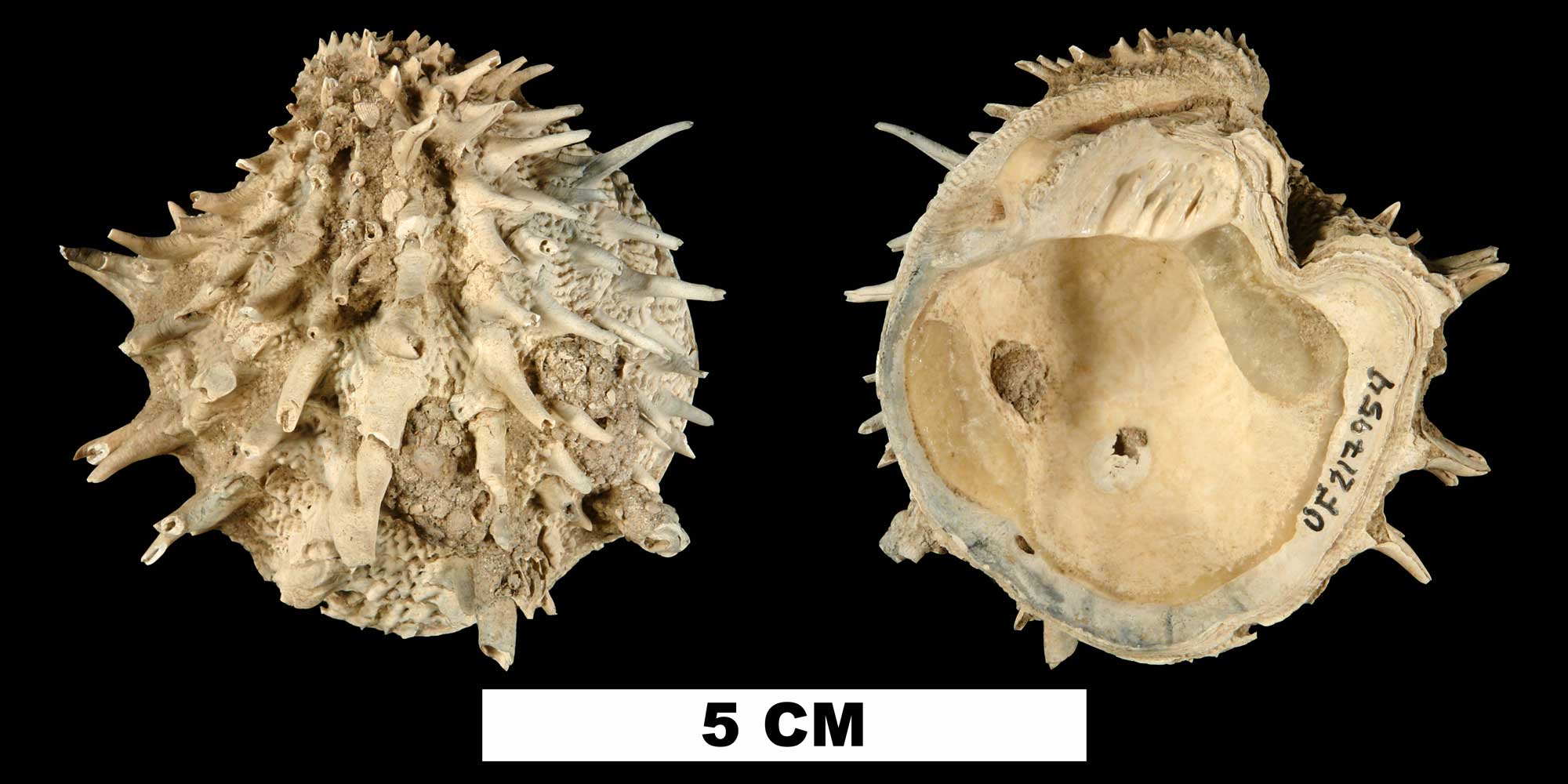
Order Venerida (Family Chamidae). Arcinella cornuta from the Late Pliocene Tamiami Fm. (Pinecrest Beds) of Sarasota County, Florida (UF 217954). Image from the Neogene Atlas.
